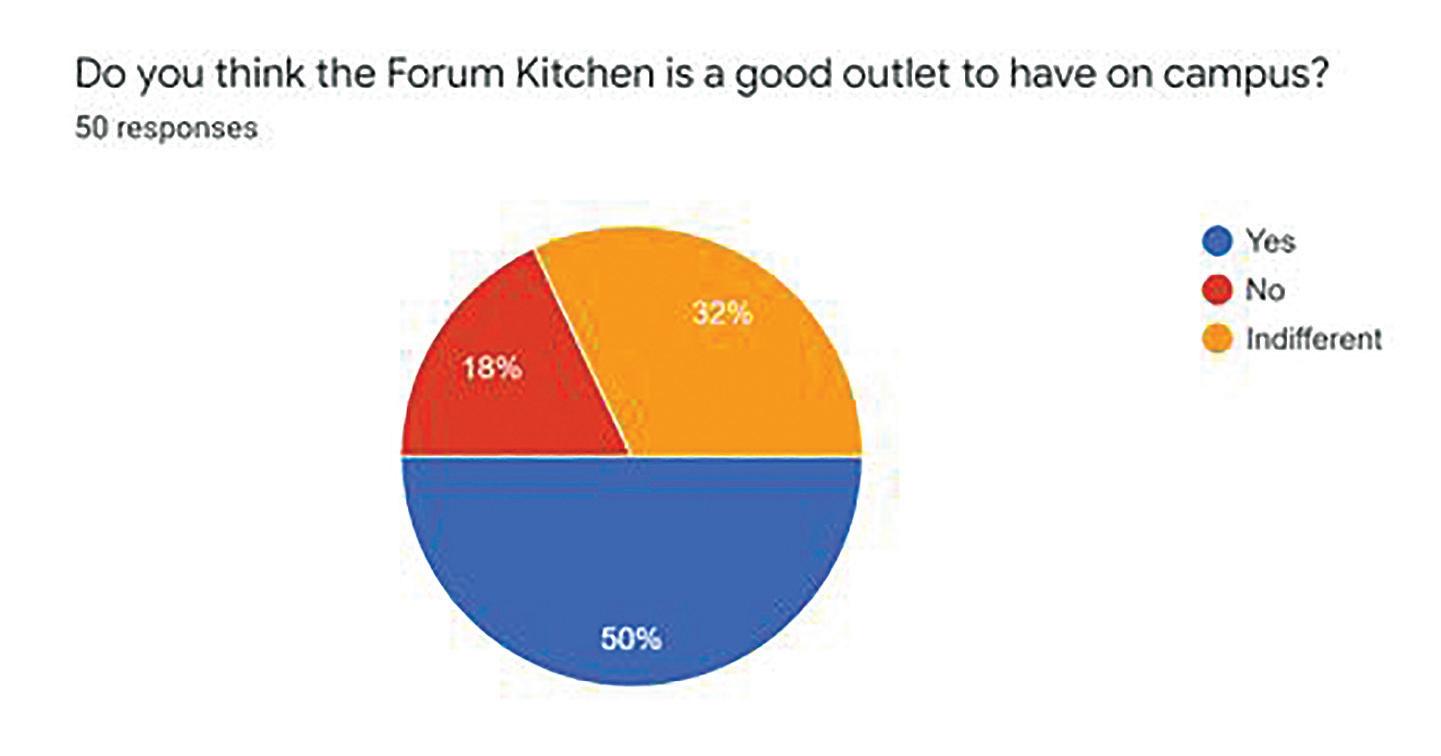exeposé


IT has recently been announced that the university are planning on rebranding. Rebranding concepts were emailed to Exeter students as well as concepts of new university logos being displayed in the Forum. Students have shared their attitudes with Exeposé, many of which have expressed negative views towards the university’s aims to rebrand. The four new concepts for university branding were created by design firm Mammoth Creative, who one student commented were “robbing the university blind” with their brand concepts. Students have shared their attitudes with Exeposé, many of which expressed negative views towards the university’s aims to rebrand.




Students have suggested that they “like the logo as it is”, that they are “not overly impressed” and that “there is no point”. One student stated that these branding changes do not make sense and “the bran-


ding currently is professional and shows the uni in a respectable light, but the suggestions make us look like a second-rate uni”. Additionally, another student commented that “the new brand looks simplistic and doesn’t well represent the university”. There have also been many students wanting to keep the current logo of the university, suggesting that “we should keep the crest, which had meaning to many”. The crest has represented the university since its official opening in 1955, therefore students from past and present are saddened that the university want to change it. The book on the current crest symbolises learning, containing a Latin inscription reading “Lucem sequimur” which translates as “We follow the light”. When asked whether students like the concepts for rebranding that were on display in the Forum, most suggested that they were not keen on the new concepts. One student commented that they “don’t like any of them particularly, although option 1 was the best of a bad bunch”. Another student followed the same line of argument, saying that they “didn’t feel any were perfect”.
There is also some concern from students who are involved in societies, especially those involved in the AU. This is due to the logo being on stash belonging to multiple societies at the university. A student expressed their annoyance about having to change their society’s stash, stating “it would make us look like a silicone valley tech start-up”. Moreover, the possible changes for some societies’ stash made the majority of students who spoke to us feel as though they are no longer representing the university. One student who is a member of an AU society at the university highlighted that the “AU bleeds green, not turquoise – so we will not be changing and we will protest if we have to change”. We also questioned students about whether they think the branding change will aid the university in making it more modern. Many students agreed that the university should be investing more in their technology and their website to aid them with modernisation, rather than having an entire branding change. Therefore, overall, most students are calling for the university to keep it branding the same and that changing it would lose the
university’s traditional and historical values. Causes for concern have also been raised by students regarding the costs of these branding changes. Students believe that there are other issues that the university should be spending their funds on such as “mental health provisions, facilities and reducing tuition”. Moreover, students have stated that the university’s money “would be much better spent ending casualisation, closing the gender and BAME pay gaps and actually contributing a fair amount staff pensions”.
Commenting on the plans for rebranding, Guild President Lily Margaroli stated that the Guild “are excited about a University rebrand as we hope this will provide a modern and cohesive new look which will better represent the University”. Margaroli also underlined that the Guild were made aware of the rebrand prior to it starting, but had not “had any input into the concepts or designs themselves”.
FREE ISSUE 733 14 JUN 2022 exepose.com @Exepose THE UNIVERSITY OF EXETER’S INDEPENDENT STUDENT NEWSPAPER SINCE 1987
Costa closes Page 3
Successfully grown in moon soil
29
Joshua Hughes and Livvy Mason-Myhill Editor and Deputy Editor
Campus
Plants
Page
The South West’s Best Student Publication
review: Obi-Wan Kenobi Page 20
Soundtrack
“We bleed green not turquoise”: students criticise University’s rebranding plans
Image: Livvy Mason-Myhill and Megan Ballantyne
Images (top to bottom): Ged Carroll, Flickr, dennis. pope85, Flickr, Pxhere
on page 4
Logos: Mammoth Creative
Continued
Editors
Print: Megan Ballantyne & Joshua Hughes
Online: Ana Anajuba & Clemence Smith
Deputies: Livvy Mason-Myhill & Elen Johnston editors@exepose.com
Executives
Social Media: Nancy Stitt



Finance: Oscar Young
Events: Georgia Balmer
Chief Photographers Rachel Cunningham
Kieran Moore
News Editors
Print: Amy Rushton
Online: Megan Haynes & Isabella Ankerson news@exepose.com
Features Editors
Print: Oliver Lamb & Austin Taylor
Online: Catherine Stone & Maggie John
International: Maeve Fitzpatrick & Ryan Gerrett features@exepose.com
Comment Editors
Print: Anabel Costa-Ferreira & Connor Goddard
Online: Izzy Langguth & Kristen Taylor comment@exepose.com
Satire Editor Print Cleo Gravett
Online: Archie Lockyer
Lifestyle Editors
Print: Pippa Bourne & Gracie Moore
Online: Ruth Hetherington & Charlie Nadin lifestyle@exepose.com
Arts + Lit Editors
Print: Ella Minty & Joshua Smith
Online: Gwenllian Page-Gibby artsandlit@exepose.com
Music Editors
Print: Megan Ballantyne, Joshua Hughes & Livvy Mason-Myhill
Online: Mahnoor Imam & Lauren Jones music@exepose.com
Screen Editors
Print: Pollyanna Roberts
Online: Matthew Bowden & Harvey Isitt screen@exepose.com
Tech Editor
Print: Harry Hawkins
Science Editors
Print: Daniel Pain & Hayley Power
Online: Daisy Scott & Imogen Poyntz-Wright sciandtech@exepose.com
Sport Editors
Print: Rob Worthington
Online: Oliver Rickwood & Archie Rucker sport@exepose.com
Proofers Oliver Leader de Saxe, Joshua Hughes, Ana Anajuba, Livvy Mason-Myhill, Kate Hall, Megan Ballantyne, Connor Goddard, Isabella Ankerson, Oliver Lamb
@exepose
It’s handover week at Exeposé and it’s that time of year when one committee leaves and a new one comes in. Putting together the handover edition wouldn’t have been possible without Ollie and Bridie’s help and we have to say a massive thank you to them and the whole committee for their incredible work this year.
The 2022-23 committee has a few familiar faces and some new as well. Be sure to watch out for the new committee and also take a look at the farewell pages ( pages 5, 6 & 7) where some of the outgoing committee have shared their experiences of Exeposé.
In News this week, we focus on the university’s plans to rebrand the current logo, looking at the different concepts they have put forward. We also look at the recent closing of Costa and the student feelings in response to this. In other news, we cover the student protests in China along with universities' plans to introduce policies to combat spiking.
In Features , the Supreme Court, guns and abortion are covered along with a review of the government’s response to the cost of living crisis (page 9 ).
In Comment , there’s a farewell to CBBC ( page 10 ) and a debate over fast fashion ( page 11 ) whilst Satire ranges from Costa closing by Royal Decree to the IMF declaring TP tickets are now a better
investment than gold bars ( page 12 ).
Lifestyle looks at the exam period this summer ( page 14 ) and showcases different accounts of local places to visit near Exeter ( page 15 ). Arts + Lit reviews the new British Museum exhibition Feminine Power: The Divine to the Demonic ( page 16 ), and provides a unique take on memoirs ( page 17 ).
Exhibit has a distinct Star Wars theme, featuring a review of the Kenobi soundtrack in Music ( page 20 ) and a nostalgic piece looking over the best of the original trilogy in Screen ( page 22 ).
Screen also gives a farewell piece to Riverdale ( page 22 ) and a detailed analysis of film soundtracks (page 23 ). Tech sheds some light on the best comfort games ( page 24 ) and Science delves into the topic of black holes ( page 28 ) and also the ground-breaking discovery of plants being grown in moon soil ( page 29 ). Sport covers a wide range of events from the disappointing season of Exeter Chiefs ( page 31 ) to the success of Exeter City (page 32 ).
We want to congratulate the new committee for doing such a fantastic job this week and also, we must thank the 2021-22 committee for everything this year. We hope you enjoy reading the handover edition as much as we enjoyed putting it together, have a great summer everyone!
Josh and Megan
UCU abandons national approach to marking boycott
STARTING the week of the 22nd May, union branches abandoned a national marking strike that has the potential to delay students graduating from UK universities. This follows the long-running industrial dispute over working conditions and pension cuts at UK universities.
In April, 41 branches of the UCU supported a national marking and assessment boycott, which was supported by 86 per cent of staff who returned ballots. Yet, following opposition from branches and member, which led to national action being reduced by the UCU’s executive in favour of letting individual campuses decide, only 20 universities are going ahead with a boycott.
Recently, the disputes have been overshadowed by university announcements of redundancies and reorganisations due to financing issues and a struggle to attract students. The UCU’s General Secretary, Jo Grady, told members: “This is not about financial need. This is about the effects of marketisation. It is about the capriciousness of research funding allocations and unregulated student recruitment”.
Student protests sparked over China’s zero-COVID policy

BEIJING students have peacefully protested against student restrictions following China's zero-COVID policy. The protests came after a wall was proposed at Peking University. The university intended for the wall to separate areas of campus used by staff and faculty from student dormitories. Half a dozen protestors attempted tobreak the barrier and were cheered on by a crowd of 200 students. Students video recorded Chen Baojan, Deputy Secretary of the University's Communist Party Committee's response to the protest on their mobile phones. Chen Baojan responded with a megaphone: "Please put down your mobile phones, protect Peking University." A student answered, yelling, "Is that protection? How about our rights and interests?". Videos shared via social media were quickly censored by the government. University administrators later agreed to remove the metal barrier and have halted further tightening of student restrictions in light of China's zero-COVID strategy.
Australia, Climate Beacon?

PAGE 8
ARTS + LIT
LGBTQ+ author spotlight

PAGE 16
TECH
Bossware: always watching you


PAGE 25
FEATURES SCIENCE
IMAGES OF THE BLACK HOLE

PAGE 28
University news home and abroad
Students win discrimination case in Japan
FEMALE medical students suing a top Japanese medical school have won compensation after a fouryear gender discrimination battle. This follows a government investigation in which Tokyo’s Juntendo University was found to have made entrance exams more difficult for female students, lowering their test scores in a bid to narrow the gap between male and female students. The court declaration confirmed this practice did not accord to the prohibition of discrimination by sex in the constitution. The Japanese medical community is frequently perceived as paternalistic, with women making up 20 per cent of doctors in Japan. Prohibition of gender discrimination in entrance exams has resulted in, for the first time, women’s average pass rate being higher than men’s in 2021. Juntendo University has been ordered to pay the plaintiffs JPY 8 million, in a move experts hope will usher in change to Japan’s medical community.
Universtities to introduce policies to end spiking by end
of the year
NEEDLE and drink spiking has become an increasingly poignant issue that needs to be addressed. A recent statement by Michelle Donelan (University Minister) explained her dedication to working on this issue and how exactly she plans to fulfil this. For higher education, data by news site The Tab reveals that 11 per cent of all students believe they have had their drink spiked. She noted that “recent incidents show that perpetrators are becoming more brazen in the way they are committing this appalling crime.” To tackle this rising problem, Donelan wants to ensure by the end of this year that all universities have measures in place for both prevention and supporting victims.
Currently, Exeter offers drink safety strips and Nottingham Trent has intervention training for night staff. As Vice-Chancellor Lisa Roberts stated: “everybody has the right to be safe and enjoy their night out with friends without the fear of spiking or violence.” Schemes like this are crucial to remind us safety is not a privilege but a right.
By Livvy Mason-Myhill, Anabel Costa-Ferreira, Elen Johnston and Amy Rushton
EXEPOSÉ Devonshire House, Exeter, Devon, EX4 4PZ Advertising editors@exepose.com The opinions expressed in Exeposé are not necessarily those of the Exeposé Editors nor the University of Exeter Students’ Guild. While every care is taken to ensure that the information in this publication is correct and accurate, the Publisher can accept no liability for any consequential loss or damage, however caused, arising as a result of using the information printed. The Publisher cannot accept liability for any loss or damage to artwork or material submitted. The contents of this, unless stated otherwise, are copyright of the Publisher. Reproduction in any form requires the prior consent of the Publisher.
Editorial
facebook.com/exepose issuu.com/exeposeexeter
Image: Storyvillegirl, Wikimedia Commons SPA AWARDS 2020 Best Publication 2022 Best Publication in the South West
@exepose
Images (top to bottom): Benson Kua from Flickr, National Interagency Fire Centre from Wikimedia Commons Mohamed Hassan from PxHere, Event Horizon Telescope from Wikimedia Commons
Royal Albert Memorial Museum returns indigenous artefacts to Canada
Catherine Stone Online Features Editor
ARTEFACTS from the Royal Albert Memorial Museum’s (RAMM) collection, consisting of sacred regalia of the famous 19th century Blackfoot leader Crowfoot, were returned to the indigenous Siksika Nation of Canada in a repatriation event on the 19th May this year. A Siksika delegation travelled to Exeter and performed a blessing ceremony on the objects. Councilor Laura Wright said that Exeter is ‘very honoured’ to see the return of the collection to “where it should be”.
In response to a Siksika request for return in 2015, Exeter City Council voted unanimously to return the artefacts in April 2020. This was unable to be carried out until this year due to Covid-19 restrictions. RAMM acquired the collection in 1904 after buying them from Sir Cecil Denny, a British policeman.
The objects will now be displayed in a Siksika cultural heritage museum in the Blackfoot Crossing Historical Park for display and education, the site of Chief Crowfoot’s signing of the 1877 Treaty Seven. Current Chief Ouray Crowfoot emphasised the place-based importance of indigenous culture, stating that Crowfoot’s “entire essence” is tied to Blackfoot territory and the return of the regalia brings cultural and historical dignity.
This action, hailed as an ‘historic event’, is part of similar efforts of repatriation taking place within a climate of growing awareness over issues of heritage ownership and historical cultural imperialism. Non-national museums and institutions like the RAMM have more legal freedom to come to restitution agreements, as in most cases the decisions lie with local councils in a case-by-case basis approach. .
“Costa had a ten year lease which they chose not to renew”: Students react to changes to outlets on campus
Megan Ballantyne and Amy Rushton Editor and News Editor
STUDENTS have had mixed reactions to changes to outlets on campus according to an Exeposé survey. This comes in the wake of Costa closing on the 22nd April, following the expiry of the outlet’s ten year lease and the outlet’s choice not to renew it. Forum Kitchen opened on the 2nd May in the Forum.
When asked if they felt Costa was a good outlet to have on campus, 40 out of the 50 survey respondents thought it was, compared to only 25 out of 50 when asked the same question in regards to the Forum Kitchen.
For Costa, seven out of 50 respondents expressed indifference to the outlet, with only three saying they thought it wasn’t a good outlet to have on campus. This is compared to 16 out of 50 expressing indifference to the Forum Kitchen, and nine out of 50 saying they thought that the Forum Kitchen wasn’t a good outlet to have on campus.
When asked how they felt about Costa closing, many respondents expressed disappointment. “Upset”, “devastated”, “gutted”, were among the responses. One respondent expressed dissapointment particularly towards the fact that this was the closure of a coffee outlet on campus, expressing that they felt there weren’t enough “relaxed café type outlets on campus, only restaurants and Pret.”

Similar responses claimed it’s outdoor seating and centrality to campus meant it was a “nice spot to meet up with friends” without needing to wait in the Pret queue.
Others expressed concerns that the Pret queue might get worse if a new outlet is not opened, “[it] means [the] Pret queue will be even bigger,” or that they appreciated having “another option if the queue in Pret is very long.” Many responsdents say they would miss the variety offered by Costa, with one pointing towards Costa paninis in particualr as “generally less expensive and better for value than Pret.”
31 out of 50 of students surveyed said that they had visited the Forum Kitchen. Students were divided about the affordability of the new Forum Kitchen, with a few responses stressing the value for money of the outlet and others that it was too expensive. One student commented that “it’s good prices, nice food and good vibes,” while another said it was “fairly expensive and takes a long time to get food.” Whilst some responses appreciated the rotation system, others claimed it means the “range of food” is limited.

One respondent expressed concern the Forum Kitchen is not as “disability friendly” as it could be, suggesting “loud music” makes the space “unaccessable for people with autism and sensory issues.”
When asked if they had any further opinions about changes to outlets on campus, students again emphasised affordability. “Affordability on campus is a massive issue that the university and Guild need

to take more seriously.” Another expressed the opinion that “It was much better when I started in 2018. There was a pizzeria, the Terrace restaurant, the Marketplace had a better variety of sandwiches.”
Variety in outlets was also a concern students expressed in the survey. “Needs to be more options – lack of variety.” Another student said “there needs to be a greater variety and more cafes.”
When asked about the recent changes to outlets on campus, a representative from the university gave the following comment:
“Costa had a ten- year lease which they chose not to renew once it expired. Costa have not approached the University about opening another branch on the Streatham Campus. Staff from the outlet were offered a number of alternatives, including the opportunity to work in other university outlets, or posts in other branches of Costa in the city. The University is hoping to be able to announce who will be replacing the former Costa store very soon.

The new Forum Kitchen builds on the success of the popular street markets on Streatham Campus. The new indoor, relaxed and modern space aims to replicate the diverse food options that the street markets offer and grow our partnerships with independent, local food and drink traders. The University has been showcasing the new space to local businesses and we are keen to encourage a diverse range of traders to set up in the pods to offer everchanging dishes and food experiences for our students, staff and visitors.”
New Multifaith Centre to open on campus
Joshua Hughes Editor
THE University of Exeter is planning to build a new multifaith centre on the Streatham Campus. The university plans to build the new centre opposite the Forum’s South Piazza on the grassed area, aiming to begin construction in 2023. The plans include for a new 50-person Muslim prayer space and a multi-faith space, along with a dedicated office for the Multifaith Chaplaincy. The new centre will replace the existing Muslim prayer rooms and multi-faith spaces in the Old Library.
Reaction from students has overall been positive with one stating it was “a step
in the right direction” and they hoped it was “the first of many future commitments to multi-faith services at the university”. Another student suggested that the building of a new multi-faith centre would be “a further step towards inclusivity”. One student stated they were “glad that Exeter is continuing to diversify and make itself accessible to students from all backgrounds”. However, one student raised concerns surrounding the location of the proposed centre. They commented, “while the commitment to a new multi-faith centre is positive, the ever-growing lack of green space on campus is concerning and something the university needs to address”. Contributing to this stance, a student also said that the centre could possibly “spoil the view”.
Commenting on the project the university stated that plans “have restarted after being paused during the uncertainty of the covid pandemic”. Speaking on the timescale of the project, the university “expects to submit planning permission for the building this summer 2022 with a view to start work on construction in spring 2023 (timescales are subject to change). For more information and for regular updates on the Multi-Faith Centre project, please visit the project web page”.
Guild President Lily Margaroli stated that the Guild are “really pleased that there will be a much-needed multi-faith centre on campus to provide a space for all students to practise their faith”. Underscoring the significance of the project, Margaroli
highlighted that “for a considerable time, the provision of appropriate spaces on campus for certain communities of students to practise their faith has been below a good standard”. She also made clear that “appropriate student reps and groups have been involved in consultations” in relation to the project as well as “various members of University staff who work with our faith groups and on equality”. Addressing the loss of green space the centre will cause, Margaroli stated that she had “been working with the relevant teams to discuss liberating other green spaces near and around the Forum”. Finally, she expressed that “if any students feel they would like to know more details about how this project is progressing, please get in touch”.
14 JUN 2022 | EXEPOSÉ 3 NEWS Image: Pymouss, Wikimedia Commons
Image: Ged Carroll, Flickr
Images made using Google Forms
Amy Rushton News Editor
EXETER resident, Graham Keene has beaten the previous record to become the oldest British person to climb Mount Everest. Keene, at 68, is three years older than previous record holder Sir Ranulph Fiennes was when he reached the summit in 2009.
Keene set the record during a 16 day “flash” expedition, which culminated in him reaching the summit on 13th May. Keene has been climbing since an expedition

Exeter grandad becomes oldest Brit to climb Mount Everest
to Kilimanjaro in 1998 with his sons Ben and Daniel, and has since tackled South Africa’s Aconcagua, Antarctica’s Mount Vinson and Ecuador’s Cotapaxi. Everest however presented a unique challenge. Keene trained throughout the pandemic with a personal trainer by hiking through Devon, using weighted packs on Dartmoor, Exmoor and the South West Coast to adjust his body to the immense physical strain required to climb Everest. Typically, such expeditions take weeks due to the need to adapt to the regulation of air, but using a
hypoxic tent during training, Keene prepared himself to climb from basecamp to summit in only a week.
As a lifetime Exeter Chiefs fan, Keene used his time at the top to unveil a flag given to him by chairman Tony Rowe. Alongside pictures of his 5 grandchildren, Keene described the experience as a “magnificent feeling” and he was “just happy to be back in the mountains with great people.”
He is now not only the oldest Brit to successfully climb Everest, but, according to the Himalyan database, one of the top twenty oldest people to ever make it to the summit.
Continued from the front page...
SPEAKING in regard to the concerns surrounding societies’ stash, Margaroli suggested that the rebrand will not affect “the stash of Guildrun societies as many societies have their own existing logos”. Furthermore, she underlined that, as a result of the rebranding being rolled out over three


years, societies would have a “considerable period of time to decide how (and if) they would like to change their logos”.
A university spokesperson stated that the rebranding was an “exciting opportunity to create a brand that represents our values, allows us to grow as an institution and reach new audiences worldwide, and align to our Strategy 2030”. Commenting on the consultation process, the university underlined that it had “involved students, staff and alumni, as well as representatives
from the wider community, to ensure everyone’s perspective, thoughts and views are included”. The university highlighted that they ran “an online survey, which was also available at the brand gallery events” allowing “participants to offer their feedback and express their preferences”. The university further stated that “the new brand is due to launch in September 2022”.
Students express concerns about international flight and passport delay
 Megan Ballantyne and Livvy Mason-Myhill Editor and Deputy Editor
Megan Ballantyne and Livvy Mason-Myhill Editor and Deputy Editor
EXETER students have shared with Exeposé their thoughts regarding the current national flight and passport delays. Staff shortages are a key cause of these national delays, and the government and travel industry dispute on who is more to blame for the drastic delays. Flight cancellations have raised concerns for those planning on going abroad, particularly during the summer holidays.
When asked about their concerns regarding having to deal with these delays and if they were worried about being trapped at the airport like many Britons across the country, students
had mixed reactions. Most students agreed that these delays were a cause for concern, especially those planning on going abroad this summer. Yet some students took a more pragmatic approach to the delays. One student answered that they were not worried as “if you plan the holiday well, you will be there very early and if your flight is cancelled there are alternative methods of transport. Book hotels to have free cancellation and you’ll be fine.”
Furthermore, despite these delays, many students explained how they were not discouraged from going abroad. Out of the students who spoke to Exeposé, multiple students suggested that they would still travel during these delays. Yet, some students iterated that although these delays have not put them off travelling, they
still consider them a hindrance to their enjoyment of travelling, since these delays don’t “sound very relaxing”.
“new passport just arrived last week.”
When asked for comment, a university spokesperson stated: ‘The university has a range of services available to offer advice and assistance to students, through the International Student Exchange and Support Office or via the SID helpdesk.’
Exeter’s historic clock tower declared unsafe
Amy Rushton News Editor
EXETER'S Jubilee
Clock Tower has been declared “unsafe” to fix. The historic tower, located on the roundabout at the top of Queen Street, stopped working during Storm Eunice in February and has not told the time since.
Alongside flight delays, passport delays have also surfaced as a national problem, with nationwide reports of some new passports taking more than the standard 10 week timeline for the passport renewal process that the Home Office suggests. Yet, for most students, this was not as concerning as the issues with travel delays. One student stated that they did not face these passport delays and that their
A spokesperson from the Guild said: “The Guild are aware of the issues surrounding travel which may affect our students, as of yet we are unaware of the scale that this impact may have. We would recommend that students follow advice to arrive at the airport with plenty of time and check for delays with their travel providers. If students find themselves stuck in Exeter we suggest they reach out to our Advice Team. who will do their best to assist them.”
The tower is hollow, with access by ladder initially required in order to wind the clockwork. A planning application submitted to Exeter City Council stated this means of access is unsafe due to “risk of falling from the ladders or landings”. Whilst infrequent maintenance updates used to service the clock once a year, increased safety concerns necessitate installing stricter safety measures before servicing resumes. The planning application added that “What was acceptable in the past is no longer deemed satisfactory”. The updated safety measures include introducing safety gas struts and latches to reduce the height it is possible to fall between platforms, and replacing the timber ladder with a stronger steel ladder.
Built in 1897, the Clock Tower was designated a Grade II listed building after traffic concerns threatened to remove it in the twentieth century. Erected by Louisa Miles in honour of her husband William Miles, the clock has become an Exeter landmark. An expert on horse welfare, Miles introduced a granite drinking fountain to the Quadrangle intersection between New North Road and Queens Street — a feature architect Thomas Andrews ensured was incorporated into the clock tower. If the new proposals are introduced, maintenance of the historic landmark will be able to continue.
14 JUN 2022 | EXEPOSÉ 4 NEWS
An “exciting opportunity to create a brand that represents our values”
Image: Rdevan, Wikimedia Commons
Multiple students suggested that they would still travel during these delays
Margaroli suggested that the rebrand will not affect “the stash of Guild-run societies”
Image: Pixabay
Goodbye committee










































Features
THE Australian Labor party is in, the Liberal-National coalition is out. Australia has voted for a change in leadership and a change in environmental policy under the new prime minister, Anthony Albanese. After almost a decade in power, Scott Morrison’s coalition government has fallen short of climate activists’ ambitions for a more environmentally friendly Australia. But why did a government that attended some of the most important climate summits in living memory under-promise and under-deliver on such a vital issue
A country famous for its beautiful coastline, wildlife and sun, Australia is also a global leader in coal energy production. According to the latest government figures, the country exports more than three-quarters of its energy output, which amounts to nearly A$80 billion. It doesn’t stop there. There are reportedly over 100 new coal and gas projects quite literally in the pipeline for Australia. With an economy so reliant upon heavy industry, and governments that have prioritised employment over
diversification, it is hardly surprising that a great many Australians find the prospect of a transition to a cleaner energy production future daunting.
The Labor Party has joined the government in prioritising employ ment but has also consistently called for more robust environ mental policies. The party’s most recent manifesto is centred around environmental conservation, with Albanese promising:
“Under my government, Australia will set a new target to reduce emissions by 43 per cent by 2030, putting us on track for net zero by 2050.”
Issues such as the repeated bleaching of the Great Barrier Reef, droughts, floods and wildfires throughout Australia have made climate change impossible to deny and impossible to ignore. The destruction of natural habitats and homes alike has turned bystanders into protestors, and vot-

ers into climate activists. Australians have taken control of their future by voting for a party that has prom-
EDITORS: Austin Taylor and Oliver Lamb
FEATURES
Hannah Fraser asks what Labor’s victory in the recent election means for climate change Australia, climate beacon?
ised to tackle these threats head on.
Albanese and his party have pledged billions of dollars to environmental policy, with $1.2 billion set to go to the restoration and preservation of the Great Barrier Reef by 2030 and $10 million each year to the preservation of Indigenous Protected Areas. On its manifesto website, the Labor Party asserts that “Australians deserve a leader who is not afraid to roll up their sleeves and do the hard work needed to get things done.” Fortunately, Albanese seems to be living up to his party’s ideals by reversing his predecessor’s wilful neglect. Less than a fortnight into his premiership, the new prime minister has announced the creation of a new environment “super-department” designed to focus on Australian climate change policy. After the previous government’s decision to cut funding for its environment department by 40 per
cent this may be the beacon of hope Australians have been waiting for.
[Albanese is] reversing his predecessor’s wilful neglect
So, what does this mean for other countries around the world who are also struggling to keep up with the ambitious targets set by the West at COP26? Australians have made their voices heard, have influenced the manifestos of their political parties, and have voted in a leader and a government that are seemingly committed to realising their election promises. In short, they have shown the world that it is possible for an electorate to push for a greener, cleaner and safer future for all, and win.
The Australian Labor Party will officially assume power on 1 July 2022. Only then will we see how committed Albanese and his fellow MPs really are to tackling climate change on a national and international scale.
Is the net closing on Westminster’s Houdini?
Elen Johnston, Deputy Online Editor, examines the fallout from Partygate
THE police have issued 126 fixed penalty notices in response to the breaking of lockdown rules at Downing Street. Rule-breaking included a garden party, a civil servant’s leaving party, and a Christmas celebration. The prime minister, his wife, and Chancellor Rishi Sunak received fines for attending a birthday gathering at 10 Downing Street.
The Sue Gray report, previously withheld for the duration of police investigations, has now been released. Gray attributed responsibility for the rule-breaking to “failures of leadership and judgement in No 10 and the Cabinet Office”.
Boris Johnson had previously told parliament that “the rules were followed at all times.” The revelations of Partygate have led many to accuse Johnson of lying to parliament. Deputy Labour leader Angela Rayner stated, “Boris Johnson said repeatedly that he knew nothing about law-breaking — there’s no doubt now, he lied. Boris Johnson made the rules, then he broke them”.
Transport Minister Grant Shapps came to the prime minister’s defence, proposing that “he didn’t knowingly lie.”

However, according to a YouGov poll, eight in ten Britons think Boris Johnson lied about the lockdown parties.
The ministerial code has previously outlined that ministers who knowingly mislead parliament are expected to offer the prime minister their resignation. How-
ever, Johnson has recently revised the code, allowing ministers not to resign after misleading parliament if they do so unknowingly. The recent change is not Johnson’s first time disregarding the document. He previously backed Priti Patel, the Home Secretary, after an investigation into her alleged bullying found her to have breached the ministerial code. The change to the code came as the prime minister faced an inquiry into whether he misled parliament.
devalue the rules, so they don’t matter to anyone anymore. So that politics becomes contaminated. Cynicism and alienation replace confidence and trust. So that the taunt ‘politicians are just in it for themselves’ becomes accepted wisdom”.
Boris Johnson’s decision to change the ministerial code faced criticism from MPs across parliament. Chris Bryant, a Labour MP and the chair of parliament’s standards committee, responded to the changes by stating: “The new ministerial code is a disgrace. It means that the tiny semblance
of accountability disappears. ‘If you break the rules, just rewrite the rulebook’ is the motto of this despicable government.”
The SNP’s deputy leader in Westminster, Kirsten Oswald, stated: “This move strikes at the very heart of our democracy and will threaten the ability to scrutinise the prime minister for years to come”.
Partygate and the prime minister’s involvement have also created unrest in the Conservative Party. Over 45 Tory MPs have publicly contested Johnson’s ability to serve as prime minister, and there is con-

cern that keeping him as leader will compromise the party’s popularity with the voters. On 6 June, a vote of confidence in Johnson was triggered. He survived, securing 211 votes to 148, meaning that he cannot be formally challenged from within the party for another year. But such a large rebellion places him in grave peril.
Johnson is known for his ability to wriggle out of situations that would end another politician’s career, but his time might finally be running out.

The ministerial code applies to all government ministers; it covers accountability to parliament, the functioning of government, civil service impartiality, government resources, propriety and ethics, and keeps the public interest separate from private interests. While the code has no legal bearing, it follows constitutional rules and conventions. There are no required proceedings for investigations into potential breaches of the ministerial code. It has historically been down to the prime minister’s discretion.
The leader of the Labour Party, Sir Keir Starmer, called out the prime minister’s disregard for the rules of parliament even before the PM revised the ministerial code, stating that “his strategy is to
14 JUNE 2022| EXEPOSÉ
8
Eight
in ten Britons think Johnson lied about the lockdown parties
Image: National Interagency Fire Center, Wikimedia Commons
Image: UK Cabinet Office, Wikimedia Commons
The Supreme Court, guns and abortion
Stanley Murphy-Johns discusses the Supreme Court’s role in two of America’s most divisive issues
THE UK is a mess. The uncodified nature of our constitution enables leaders to act as they wish rather than in the interests of the public, but even now the USA seems determined to prove that a codified constitution causes even worse scenarios.
Last month, leaked Supreme Court documents implied the court’s intention to overturn Roe v Wade , a landmark decision in 1973 where the Court ruled that the Constitution protects a pregnant woman’s liberty to have an abortion. If it is overturned, roughly half of the US states are expected to immediately pass legislation outlawing abortion. It feels to many people in America and around the world that such a decision would be a gigantic step backwards, removing freedoms which many fought hard to get.

Half of US states are expected to outlaw abortion
A study from 2022 by Pew Research Center found that 60% of Republicans believed abortion should be illegal. During his presidency, Donald Trump said, “Unborn children have never had a stronger defender in the White House”; he also attended the ‘March for Life’. As such, it can be assumed that Trump’s three Supreme Court appointments have had a significant impact on this impending ruling, as currently conservatives have a sixthree majority in the Court. As such, America finds itself in a position where basic constitutional rights of women which have been enshrined for almost 50 years are under serious threat.
Whilst the vicious abortion debate continues to rage, there is also a serious gun control issue in America, an issue that has existed for many years but that has been placed in the spotlight once again in the wake of the horror and devastation of the most recent mass shooting in Texas. At the time of writing we are halfway through 2022 and already this year America has seen 246 mass shootings, a statistic which feels almost beyond belief.
Around the world, moments of disaster and despair such as these spur nations and politicians into action. Within three months of the Port Arthur massacre in Australia in 1996, the conservative government drew up and enacted strict gun control legislation and since that point there has not been a single mass shooting in Australia. A similar story can be found in Britain after the Dunblane massacre. But America has repeatedly refused to follow suit. Currently, American schoolchildren are taken through protocols for a school shooting because gun violence is so abhorrently common that it seems practical to prepare for it. Polls show that around 90% of Americans are in favour of stricter gun control, which would be very promising if it weren’t for the significant number of statistics also implying the opposite. Furthermore, the importance of funding from the National Rifle Association to the Republican Party means that even with overwhelming popular support, a significant number of US politicians will never vote in favour of gun control.

Already this year America has seen 232 mass shootings
Here again the Supreme Court will have a large say. It is expected to strike down a New York law restricting the right to carry guns outside the home. As such, in the coming months the Supreme Court is faced with two extremely significant decisions to make which will impact the future of America. Both situations are surrounded by a cacophony of protests on both sides, and it seems almost certain that any decisions taken will leave the US even more divided. In the case of Roe v Wade , perhaps the outrage brought on by the leaked documents will be enough to spur a new verdict from the Supreme Court, whilst in the case of gun control, perhaps at last America has reached a tipping point, where it can no longer find itself beholden to the Second Amendment.
The government response to the cost of living crisis
Lucy Evans explores the measures the Conservative government is taking in response to the crisis


IN March, Chancellor Rishi Sunak set out his Spring Statement, a large section of which focused on addressing the rising cost of living. Part of this concentrated on energy bills. Alongside measures dedicated to helping the public with the cost of living and inflation — including a 5p fuel duty cut and an increased threshold for National Insurance repayment. Sunak also included help with energy bills, with a £200 discount for households that would need to be repaid over a period of time.
Sunak’s approach to helping people with their energy bills received mixed reviews, with some asking if these measures were enough. Whether it was in response to this or instead as a reaction to the likely £800 increase in the energy price cap we do not know, but the Chancellor has now announced new measures to assist the public with higher energy bills.
The Chancellor announced new measures to help with bills
26 May saw Sunak unveil these new measures, including a £400 grant for energy bills that will not need to be repaid, unlike the earlier £200 loan, and a 25% windfall tax on oil and gas profits for the next 12 months. In theory, these measures certainly help address the energy crisis more than those
unveiled in the Spring Statement, but how will they hold up in practice?
The shift from a loan to a grant is the first major difference that will really have a big positive effect for households. Instead of having to repay the £200, effectively a short-term solution that could cause further problems down the line, the £400 grant will alleviate the energy bill burden for those that really need it.
The new measures also include a £650 grant for the worst-off households, according to The Guardian. This increased grant acknowledges that individual households will have different needs and is designed to lessen the burden of increased energy prices on the families that will really feel the pinch in these coming months.
It remains, however, that the government is limited in what it can do and cannot solve the issue completely, a fact that the prime minister has admitted. The Independent reports that in the Downing Street press conference on 25 May, Boris Johnson commented, “It won’t be easy, we won’t be able to fix everything”, opening a conversation on the limitations of the government during this time of crisis.
These admissions, while selfaware, only draw attention to the fact that even with these new measures in place, some families will continue to really struggle over the coming months and years as energy prices continue to rise, emphasis -
ing how although these measures alleviate the burden in theory, families might continue to struggle in reality.
The 25 per cent windfall tax that has also been announced could possibly raise £5 billion, according to BBC News . In their words, the intention is to “target firms that were lucky enough to benefit from something they were not responsible for”. The tax also has the potential to directly help the harder-hit households of the energy crisis. The i has commented that “the money recouped from the tax could then be used to help households that have been hit hard by the rise in energy prices, as well as businesses that are struggling as a result”, alluding to a redistribution of wealth that will further assist harder-hit families.


This decision to introduce the windfall tax has not been made without criticism or reluctance, however, with The i reporting that both Johnson and Sunak wanted to encourage those companies to invest.
With the windfall tax announced and an increased grant expected for British households, hopefully the British public will have some financial alleviation in the face of this energy crisis.
14 JUNE 2022 | EXEPOSÉ 9 FEATURES
The government is limited in what it can do
Image: Alisdare Hickson, Wikimedia Commons
Image: Legoktm, Wikimedia Commons
Comment


COMMENT EDITORS
CONNOR GODDARD & ANABEL COSTA-FERREIRA
US gun control: The struggle for reform
Oliver Lamb, Features Editor, discusses the complexities behind gaining ‘sensible’ gun reform

GUESS how many mass shootings took place in the United States in the ten days following the massacre at Robb Elementary School in Uvalde, Texas. One? Two? Try 20.
It hasn’t always been this way. Mass shootings have tripled since 2004, when a ban on assault weapons expired. President Biden recently called for a new ban, but even the most moderate gun control proposals are doomed to flounder on the rocks of partisanship in Congress.
President Biden recently called for a new ban
That ban on assault weapons was passed in 1994. Those were simpler times; since then, a chasm has opened up between Republicans and Democrats. The former champion gun rights, the latter gun control. It
is just one front — alongside race, abortion, the economy and more — in the battle for America’s soul.
What’s strange is that a majority of Americans support measures like universal background checks on gun buyers.
Moreover, Matt Bennett, of the centre-left think tank Third Way, believes that many Republicans are privately sympathetic to gun control reforms.
Yet two groups stay their hand.
One is their own supporters. 30 per cent of Americans own a gun, and reform-minded Republicans fear losing votes to hardliners. This is all nice and democratic, but Republican lawmakers are also
financially beholden to the National Rifle Association, one of America’s biggest lobby groups. While we shouldn’t overstate its power — other political donors are available — the millions that the NRA spends each year on influencing politicians loom large in the gun debate.
Part of the argument for guns is that they enable decent people to protect themselves. But for many, gun ownership means more. It is a right second only to freedom of speech.
The Bill of Rights agrees, listing free speech and gun ownership first and second. America’s Declaration of Independence is ideologically
premised on the belief that a people has the right to overthrow a tyrannical government. Gun rights, according to their advocates, are enshrined in the constitution to provide Americans with the means, if necessary, to do just that.
Gun rights are enshrined in the constitution ... to provide Americans with the means [to overthrow a tyrannical government]
Was the reasoning behind the Second Amendment really so grandiose? Maybe not, but millions of Americans believe it was. That explains why, in the context of the culture war — where the other side is your enemy — sensible reforms morph into assaults on liberty that must be resisted no matter the cost.
To be or not to BBC?: BBC Four and CBBC to move online
Livvy Mason-Myhill, Deputy Editor, discusses the BBC’s decision to take the channels off the air
THE BBC have recently announced that CBBC, BBC Four and Radio 4 Extra will be shut down and become online-only services as the focus on streaming services is becoming increasingly popular. This follows a statement by Tim Davie (BBC Director General) who said that “this is our moment to build a digital first BBC. Something genuinely new”. These changes to the BBC were enacted as a response to the freezing of the licence fee at £159 for the next two years decided by the Culture Secretary Nadine Dorries.


likely to be outraged by the BBC’s unfavourable announcement.
T hese changes bring multiple negative consequences including cuts to local television and radio services in England and according to the BBC, over the next five years about 1,000 jobs will be lost at the broadcaster after years of cuts and redundancies. Viewers, employees, and politicians are
The move to streaming services by the BBC also affects millions of Britons who are older or from lower-income backgrounds. Those who do not have access to the internet or access to the home broadband that is required to access streaming services will struggle to remain loyal audience members to the BBC. Shutting down BBC Four in particular will bring backlash from its loyal audiences. This is due to the channel in recent years essentially being an archive-only channel. The newer BBC Three channel which is more youth-focused will remain on our televisions, despite BBC Four beating it in the ratings with its successful vintage architecture programmes and classic Top of the
Pops
episodes. I am sure many people will greatly miss watching nostalgic episodes of their


engaging parts of my day. I would spend hours watching programmes like Blue Peter, Dick and Dom and Tracy Beaker. These children’s shows on CBBC were extremely beneficial in engaging children both to entertain them but also to teach them materials outside of the classroom.
Although this may be considered as a step forward within the modern world we are now living in, I am disappointed that children will be robbed of what I considered to be the best children’s television channel. Children’s television will never be the same.
favourite BBC show from the past. Personally, I grew up watching CBBC and I am saddened that this nostalgic television channel is being moved to streaming services. Tuning into CBBC after coming home from a busy day at primary school was one of the most

I especially remember learning all of the songs from Horrible Histories and getting my friends to test my well-tuned skills of knowing all of the kings and queens of England. This unfortunate move to streaming services means that children will not be able to access CBBC as easily, especially children who come from low-income backgrounds. This also means that children miss out on an aspect of childhood that I valued greatly as a child.
The move to streaming services affects millions of older Britons
14 JUN 2022| EXEPOSÉ 10
Enacted as a response to the freezing of the licence fee
Image: Lorie Shaull, Flickr
Image: Rhoddie Giles, Geograph
1,000 jobs will be lost at the broadcaster
Image: Diddybob345, WikiMedia Commons
The rights and wrongs of fast-fashion
Ella Minty, Arts + Lit Editor, and Anabel Costa-Ferreira, Comment Editor, debate whether we should renounce fast fashion brands
We shouldn’t cancel fast fashion
FAST fashion, although atrocious for the environment, is simply some people’s only option. As the cost-of-living is soaring and people are struggling to pay bills, the least of a struggling single mum’s worries is clothing themselves in the usually more expensive, sustainable fashion. Brands like Primark, Missguided and Pretty Little Thing are often slated for their impact on the environment, but what about the people who have little choice in the matter?
The least of a struggling single mum’s worries is clothing themselves in sustainable fashion
Fast fashion is cheap, accessible and readily available on the high street. The garments are produced at high speed and low cost, in often poor and unlawful working conditions by underpaid workers. It has been displayed recently through a scandal surrounding Boohoo. Boohoo’s supplier were allegedly paying workers £3.50 an hour in unacceptable working conditions. Although this is awful, there is no middle ground; shopping ethically is time consuming and expensive. In addition, through peoples’s ethical boycotts of fast fashion, people from lower-income backgrounds risk being excluded from fashion as a whole as ethical shopping is becoming more and more popular.
Charity shops are a good option for stalling the production of fast fashion; however, due to the



second-hand market becoming so popular online, they have had to up their prices. So, it seems that despite all the negatives that fast fashion produces, it is some people’s only option and will stay that way unless something changes drastically.


The fact of the matter is that in a world where image is everything, fast fashion has allowed many people with a limited budget to dress ‘on-trend’ who would not have been able to afford to buy more expensive brands.
Ella Minty, Arts + Lit Editor
We should cancel fast fashion

S the recent news of Missguided’s fall into administration a sign that fast fashion is quickly losing popularity? After already being ‘rescued’ last year by financial firm Alteri Investors, this well-known online retailer is being exposed due to a multitude of debts and overdue payments. Following legal pursuits, and a police visit to the Manchester headquarters, these serious allegations quickly led to its collapse on Monday, May 30th. And whilst its previous competitors may not be falling into debt, news like this leads us to wonder: is Missguided’s collapse a glimpse into a future free of fast fashion?
As a result of the pandemic, online clothing brands witnessed a predictable rise in sales, but as pandemic restrictions reduced it appears to follow the online traffic. One of the partners at corporate firm Begbies Traynor stated that “Missguided boomed when we were locked down with no opportunity to spend wages going out, the harsh realities of postpandemic life are becoming clear.” At an unprecedented time in our lives, online shopping became the new normal, not only was it timeefficient but cost-friendly. The tempt-
ingly low prices and sales, the thought of not having to leave the house to pay for petrol and queue — who could blame you for ordering those payday treats online? As life continues, the post-pandemic world faces inflation and the cost of living and bills continue to soar, leaving people with less money for the non-essentials.
Fast fashion is quickly losing populairty
Zara coined the term ‘fast-fashion’ in the 90s and said it wanted to be able to design and mass-produce items in a matter of weeks. The term now continues to embody the disposable nature of fashion and trends — where individuals will buy an item only to wear it a handful of times before it will be inevitably swapped with a more up to date and stylish item. Though the harsh reality of underpaid workers, poor living conditions and toxic textiles that exists behind this glamourized world ought to lead us to consider our morals when choosing which retailer to purchase from. Yes — while these fast fashion brands may be cheaper, sustainable brands provide higher quality garments that become timeless staples to your wardrobe. Now, this is not to say you must rid yourself of shopping at these brands immediately, but we should all open our minds to alternatives.
 Anabel Costa-Ferreira, Comment Editor
Anabel Costa-Ferreira, Comment Editor
11 COMMENT 14 JUN 2022| EXEPOSÉ
Shopping ethically is time-consuming and expensive
Image: Stefan Muller, Wikimedia Commons
Image: Pixnio
Image: Ryan McKnight, Flickr
Image: Gary Knight
IMF declares TP tickets better investment than gold bars
WITH the current global market so unstable on the back of a pandemic and the war in Ukraine, most investments would be unwise at this moment. However, the International Monetary Fund has drawn attention to one line of investment which remains extremely lucrative: not property, gold or diamonds; at the moment the largest return on investment can be found in TP tickets.
The resale value of TP tickets is exponential and threatens to destabilise the local economy entirely. Tickets which initially cost roughly £5 have allegedly been sold for over £50 thanks to the desperate scramble to attend a depraved three storey crack house with LED lighting. In fact, a profit can even be made on a ticket for TP Saturday — a night filled with the constant danger of being beaten up by marines or simply becoming a local.
To conclude, if you’re looking to use daddy’s money to invest, invest in TP tickets: the fastest moneymaking scheme Exeter has to offer.
Stanley Murphy-Johns
Campus Costa closed by royal decree due to refusal to take part in Jubilee celebrations
STREATHAM campus Costa Coffee has been closed by royal decree as a result of its vehemently anti-monarchy stance. The Buckingham Palace press office said that the recent release of the Iced Guillotine Latte and ‘all you can eat the rich buffet’ was the final nail in the coffin and left them little option but to close the coffee shop.
Queen Elizabeth was saddened by this stating that “One really liked their ham and cheese toasties”. In response, branch manager Katrina Puccino has announced she will be opening her own coffee shop and has trademarked the name ‘Too little too latte’.
Joshua Hughes, Editor
Government advises burning printed dissertations to keep warm during the energy crisis

Crisis:
DissertationCHEM42069:
Kate Hall Comment Editor


AMIDST soaring gas and electricity prices, the government has advised students to keep hold of copies of their dissertations,
Harold Hawkins Tech Editor
FOR years budding students, unable to dispose of glass bottles collected as trophies of house parties past, have had to find modern solutions. One of the most
printed for humblebrag photographs and general bookshelf-cluttering, in order to survive the upcoming winter. The bulk of non-reclaimable-sanity allegedly ‘does make great kindling’ according to Lucy Wilterlive, who has already burned hers for fun. The announcement comes after
many graduating students expressed their dismay at the various crises they are set to graduate into, namely the cost of living and unaffordable energy bills. After much backlash, one government official responded emphasising that ‘there simply isn’t room in the budget alongside our
Bottle Banksy!
successful solutions has been the creation of displays and exhibitions in Exeter’s art galleries: a move that has been applauded by the global art market.
Auctions have snapped up pieces such as ‘Forty-One Stellas’ and ‘The Persistence of Moretti’ with aplomb, speculating that the value of such ‘provocative, elegiac and alcoholic’
Alexander Prins
F
scheduled Christmas work meetings’.
to a schedule and meet deadlines.”
OLLOWING a record number of mitigated undergrad dissertations, the University of Exeter announced this week that Ryanair would be sponsoring a dedicated delayed graduation ceremony, held three weeks later than originally planned. Regional Ryanair spokesperson Michael Taker told Exeposé that the airline intended to “Embrace our quirky reputation, by supporting those students who also struggle to stickThe University warned however, that due to difficulties with logistics it would not be possible to hold the ceremony in the Great Hall as planned, but that alternative arrangements had been made to host the event next Wednesday at 6am in London Stansted’s Terminal 2.
To make up for this, a variety of “Graduation Packages” were also announced: ‘Economy Basic’ will include one degree certificate* and two restricted legroom guest seats. ‘Economy Plus’
pieces would appreciate even higher than student accommodation rents. However, difficulty has arisen with
Auctions have snapped up pieces such as ‘The Persistence of Moretti’
offers an additional guarantee that an attempt will be made to pronounce names correctly, and graduation robes will match the size requirements chosen. ** ‘Economy Gold’ will include all of the above, and one nonrefundable return trip to any of the airline’s European destinations.*** When asked for comment, the University of Exeter described the landmark sponsorship agreement as being “In keeping with our values and treatment of students”, and “definitely not part of a wider tax avoidance scheme”. One student told Exeposé, “I was
some students significantly altering their artwork by rummaging through the piece to search for one last pre-drink. It must be said that this is not the only astute use of discarded drinks — the more doom mongering of students have been stockpiling bottle caps in case they become currency in the event of nuclear fallout.
sceptical at first, because my trip to Zante last summer ended up being delayed by three days and my luggage got lost in Budapest, but considering I haven’t even started my dissertation yet, I don’t really have a choice.” An additional £15 certificate printing charge will apply.
** To within three sizes, thanks to a partnership with H&M. Provided that destination is Dublin – full charges will apply to alternative choice airports.
SATIRE EDITOR: Cleo Gravett 14 JUNE 2022| EXEPOSÉ 12
Satire
“Solving The Energy
A Study
-
Penny De Zelle
The bulk of nonreclaimable-sanity allegedly ‘does make great kindling’ credits: pxhere.com, Pixabay (user AlLes)
Into Renew
able Fuels”
Image
DELAYED: Ryanair sponsors late graduation







21 ‘RUNNING UP THAT HILL’ TO ‘80s NOSTALGIA LIFESTYLE ARTS + LIT MUSIC STUDY BREAK SCREEN LIFESTYLE EDITOR Pippa Bourne Gracie Moore 14 - 15 ARTS + LIT EDITORS Ella Minty Joshua Smith 16 - 17 MUSIC EDITORS Megan Ballantyne Joshua Hughes Livvy Mason-Myhill 20 - 21 SCREEN EDITOR Pollyanna Roberts 22 - 23 STUDY BREAK Puzzles by Matthew and George 27 STUDY BREAK 27 Image: The Blue Diamond Gallery 14 POST-PANDEMIC LIFE NOSTALGIC CINEMA Image: Ivan Radic, via Flickr Image: Wikimedia Commons, Neale Haynes 25 BOSSWARE - ALWAYS WATCHING YOU TECH 24 - 25 TECH EDITOR Harry Hawkins Image: Darryl Moran, Flickr WRITING OF WAR AND EXILE Image: Steven Haywood Image: Pixabay, Altairayon 17 22
lifestyle
Post-pandemic life
Livvy Mason-Myhill, Deputy Editor, discusses her academic experiences after the removal of all COVID restrictions
AFTER experiencing nearly two years of life during a pandemic, one could forget what life was like before COVID-19 hit. Social distancing, isolation periods and facemasks had become our new form of reality. However, after the Government officially removed all previous COVID restrictions in February of 2022, we were reintroduced to a life that we once saw as normality.
As a first-year student at University, I have found that the lifting of these restrictions had greatly aided me academically. Unlike previous year groups over the past two years, I have been able to have all my lectures and seminars in person as opposed to having them online. This means I have better concentration on my course and I don’t struggle to find motivation. I also have the confidence to participate and be academically active, particularly in my seminars. Suggesting ideas and thoughts to my seminar leaders and getting their feedback is far more rewarding and useful in person now that restrictions are not so strict.
Furthermore, this return to near normality has also impacted my social life at University.
Without the restrictions of social distancing, I have the freedom to talk to new people in person, being able to make friends wherever I go, whether I find people who are in the same accommodation as me, on my course or even people I met out clubbing during Fresher’s week. Finding lasting friendships at University would have been so much more challenging if the restrictions were tighter or if we had been put in another national lockdown.
Therefore, I am extremely grateful that the Coronavirus restrictions were lifted during my first year. However, I appreciate that the lack of restrictions has raised some concerns for people, particularly those who are medically vulnerable. University is an immensely social environment and with a lack of restrictions, it is understandable that some are concerned about COVID-19 spreading. Although the Coronavirus pandemic is still upon us, with levels of COVID-19 being put into Level 3 recently by the Government, there is certainly a light at the end of the tunnel with social and academic life finally returning to normality.
Exams 2022: A Success?

feelings towards Exeter's wellbeing
AND breathe. The tension releases in my shoulders as I click the “submit assignment” button for the final time on e-BART. Without a doubt, this year’s exam period was harder than both my GCSEs and my A Levels in terms of stress — and there were only six exams to take!
It is easy for one to get caught up in persistently aiming for Firsts because it is important to “make the most of the £9000”. However, as students of a Top 20 UK University, the stress can build this way. Many a breakdown has been had over the last month and many a Fever Monday ticket has been regrettably sold on Overheard to make room for an allnighter of revision. But was it all worth it?
Exeter have been remarkable in alleviating these worries and panicked nights in, hunched over Quizlet flashcards. The effort that struck me the most was the Wellbeing team being on-hand to talk about exam pressure while students were given the opportunity to have cuddles with some adorable piglets at the same time. From personal experience, this worked. Also, the idea of drop-in sessions with the Wellbeing team reassured me greatly. As much as I didn’t feel like I needed to make use of these, it was comforting to know that they were there if necessary. And that’s the most important thing.
It is evident that at Exeter, the tutors also really care about the students they teach. The stereotype we are fed at school suggest-
ing that University tutors will just lecture us for an hour and offer no real emotional support, is wrong. During many Spanish language seminars when I have been heavily doubting my abilities, my tutors have always been ready for a pep talk and some reassurance. Even this goes a long way to getting my motivation back on track. My exams went well generally but, as the University kindly reminded us, doing my best was enough and always will be, no matter the outcome of the exam. So, my advice would be: make use of the wellbeing team here — they really know how to make you feel better! Also, balance is key: don’t spend a week of allnighters revising, use that Timepiece ticket on Wednesday! See your friends for lunch as you planned! I promise you’ll need these interactions when motivating yourself during the slog of those 24-hour exams.
SINCE the summer of 2020, online exams have created stress and anxiety. In what already is an uncertain period, the confusion created by online exams is concerning and the long-term effects are yet to be seen. Some speak positively about online exams, referring to the benefits of being able to complete exams when they please in comforting environments. However, the negative side of online exams paint a picture of a lack of knowledge surrounding the parameters, people spending the full 24 hours, slaving over a laptop through day and night. Friends have spoken about confusion, receiving conflicting emails surrounding the word counts of questions leading to an unnecessary amount of time being wasted. The most recent round of exams has been partially online and it’s encouraging that the university has moved some back in person. Completing an oral exam online is not an enjoyable experience — es -

pecially if you’re being examined on your spontaneity. What is also beneficial is that students have now become more accustomed to having exams online, and hopefully stressful experiences have encouraged students to prepare for disruption.
Exams are meant to be a test of knowledge and understanding of the subject, not of how often you check your emails or how quiet your flatmates may be during a 24 hour period. There is a significant disparity created among students by online exams, and although some may suggest that it allows for their time to be managed more effectively, an unfair environment is created.
After two years of online exams, the university now has a choice. Either it can continue to promote the use of online exams, or it can attempt to return to a period of normality. However, it feels it is clear that online exams will become the norm and if this is the case, the university has a duty to be organised and respect the interests of students.
EXAMS ARE MEANT TO BE A TEST OF KNOWLEDGE
Gracie Moore and Joshua Hughes, Lifestyle Editor and Editor, talk about their
Gracie Moore, Lifestyle Editor
Ivan
Joshua Hughes, Editor Flickr
Image:
Radic, via
Image: NTB Scanpix
You must be tripping?

Lifestyle writers share their thoughts on Exeter's best summer days out

Dawlish Warren Chagford

MOST of us would agree that the most popular seaside destination for students is Exmouth. The long stretches of perfect sandy beach, the shops along the promenade perfect for grabbing yourself a cold, preferably alcoholic drink and the pleasant, seaside atmosphere all make this a great place to hang out with friends and forget that exam season ever existed.
But without a doubt, Dawlish Warren is my favourite beach spot near Exeter. It’s a slightly shorter train journey than to Exmouth and once you’re off the train, you’re only a short walk from the beach — so you don’t need to lug all your things 15 minutes back and forth to actually reach the beach itself. Food outlets are close to the water, serving classic seaside food like fish and chips or hotdogs and snacks like slushies, ice creams or, my favourite, hot donuts! There are also shops where you can buy inflatables, sunglasses and other important seaside memorabilia so it’s no problem if you suddenly find yourself yearning for an inflatable flamingo or a bucket and spade.
DAWLISH WARREN IS A MUST-GO!
If you just feel like lying in the sun, reading a good book and potentially dipping your toes
in the water, then Dawlish Warren is incredibly accessible from Exeter and has everything you could possibly need — but if you are looking for a bit more of a varied, adventurous trip, then Dawlish Warren really comes into its element. The adjacent funfair offers thrilling rides to rival those at the Enchanted Garden Ball (EGB), alongside Gokarting and mini golf, making for a perfect day out with friends. Elephant Rock, just a short walk from Dawlish Warren beach, has a wonderful view over the coastline. This is the perfect spot for a relaxing picnic and an Instagram post — just make sure you’ve got decent shoes because it can be a little scrabbly on the way up!
In the nearby Dawlish, there are also black swans, brought all the way from their native countries of New Zealand and Australia. The town is a two minute train journey from Dawlish Warren beach. It is full of fish and chips shops (Rock 'n' Sole Fish Bar is my personal favourite!), so grab yourself some food and sit along the sea wall watching the sunset and munching on chips for impeccable vibes!
So if you’re indecisive like me and can never decide between having an exciting day trip or passing out in the sun, Dawlish Warren is a must-go! Just watch your food carefully — the seagulls are vicious here!
Megan Ballantyne, Editor
LAST summer I went with some friends to Chagford in Dartmoor for a mini-break. Chagford was amazing, situated in the heart of Dartmoor it is the perfect place to go on a weekend for students at Exeter. We went by car but it is also possible to take the bus and the nearby town of Okehampton has a recently reopened train station.
ALTHOUGH IT WAS ON THE PRICY SIDE, IT WAS CERTAINLY WORTH VISITING
The main reason we chose Chagford was as a result of the sheer number of pubs it has.
The Chagford Inn, Three Crowns, Globe Inn and Ring O’Bells all have unique aspects and attractions. At each pub, we decided to both drink and eat to gain insights on the overall experience. The Chagford Inn was cer tainly a highlight, quiet with great staff and very experienced bartenders. Having mojitos made with mint
And everything else!

T'S been a struggle, but we’ve made it to June. A month for celebrating the end of exams, relieved from the pressures and constant stresses of the exam revision cycle before the end of tenancies arrive. And, despite COVID-19 having postponed this 'university' summer for the past couple of years, the time has finally come to make the most of the warmer southern weather and the beautiful landscapes and beaches of Devon.
First stop: Exmouth. Arguably the most popular of the Exeter choices for a summer excursion. Celebrating the end of exams? Prosecco on the beach.
Birthday? Classy M&S picnic on the beach? All whilst the sun is (most probably not) shining and you can gaze over the sea whilst trying not to get splashed by dogs or your ice cream stolen by the seagulls. Seriously, watch out for this, I’m still traumatised. However, the cheap price of the train ticket, especially from St James’ Park, makes the thought of a day out to Exmouth even more appetising.
UNIQUE ASPECTS AND ATTRACTIONS
If you’re looking for a quieter beach filled with tranquillity and serenity, Sandy Bay
beach is a hotspot. Just 30 minutes from Ex eter by car, the short stretch of sand is the perfect place to finish a good book or have a few hours’ nap while catching some rays.
If lazing around on the beach isn’t up your street and you’re an adrenaline junkie looking for competition, AS Watersports by Exeter Quayside has you covered. They have a choice of kayaking, canoeing and paddle boarding as well as boat racing — the perfect activity if you’re a larger group. Another more active option, also perfect for a university society end-of-term day out, is paintballing at Exeter Paintball and Laser Game. But beware, however fun at the time, the bruises in the following couple of days would say otherwise.
And finally, an Exeter University education and experience would not be complete without a trip to Pennywell Farm. And what could be more ideal than a Piggies and Prosecco Even ing to celebrate the end of exams and freedom with friends? The event includes plenty of Prosecco, piggy cuddles and stonebaked pizza. What more could you ask for?
Pippa Bourne, Lifestyle Editor
leaves from the garden was particularly fun. The Three Crowns was more of a restaurant and less of pub, yet the dining experience was fantastic. Although it was on the pricy side, it was certainly worth visiting. The Globe Inn was the quirkiest visit. In a traditional setting, the pub was great and the food also great, while surprisingly pricy. The Ring O’ Bells was the only pub we didn’t eat at and instead had a great conversation with the local crowd.
This is very much an article about Chagford and why it is a great place to go and pubs are a central part of that and the local atmosphere. Apart from the pubs, the Airbnb was great, located only a short walk from the Chagford Inn – possibly clouding our judgement. The hosts at the Airbnb were extremely kind, giving us a great insight on the village and nearby hiking routes around. Hiking to the top of the nearby hill greeted us with an unexpected sight, a heard seemingly of wild horses. I cannot recommend Chagford enough and if you are looking to explore Dartmoor, it is a great place to base yourself!
 Joshua Hughes, Editor
Joshua Hughes, Editor
exhibit | lifestyle e D itOR s : Gracie Moore and Pippa Bourne 14 JUN 2022 | 15
Image top, left and right: Roger A Smith, Geography, Lee, Flickr, Nigel Thompson, Geograph
arts + lit
LGBTQ+ author spotlight
As we head into Pride Month, Ella Minty, Arts and Lit Editor, talks about her favourite LGBTQ+ authors

Alison Bechdel
ALISON Bechdel is best known for running the comic strip Dykes to Watch Out For for 25 years, yet I think her illustrated memoir, Funhome: A Family Tragicomic is her most impressive achievement. It traces her journey from young girl to young adult as she comes to grips with her own lesbian sexuality, her father Bruce’s death and his secret homosexuality that he kept hidden throughout his life whilst having affairs with underage boys. What is particularly pioneering about Funhome is its form, where Bechdel mixes illustration with words to create a unique comic-style novel which confronts dark themes but is also humorous as well. It’s so unique but works perfectly to portray Bechdel’s rocky journey into adulthood.
Bechdel has worked to create her own literary tradition which has been so successful Funhome became a Broadway musical in 2015 and is the first Broadway show with a lesbian protagonist. It received positive reviews because of its focus on the individual experience of a lesbian, including winning five Tony awards in 2015. She is also known most famously for the Bechdel Test: to pass, a fictional work must have at least two named women who talk to each other about something other than a man. Very few movies and books pass this test, The Great Gatsby being a famous example of failing the Bechdel test. Bechdel’s work focuses on the theme of self-discovery and identity and is intimate and personal; I think this is why her work has always received such positive reviews
Jeanette Winterson
JEANETTE Winterson is another lesbian author who has used personal experience to influence her work. Her novel Oranges Are Not the Only Fruit is semi-autobiographical, a coming-of-age story about a lesbian girl who grows up in a Christian community. The main character is a young girl, adopted by evangelists so she believes she is destined to become a missionary, but as an adolescent, Jeanette finds herself attracted to another girl, so her mother’s group of religious friends subject her to exorcisms. Although it’s sometimes referred to as a “lesbian novel”, Winterson has objected to this label, arguing that straight fiction is supposed to be for everyone but LGBTQ+ fiction is only for the LGBTQ+ community. Winterson is a pioneer of LGBTQ+ fiction: since 1985, when Oranges was published, she has published numerous novels with LGBTQ+ characters. For example, inspired by Shelley’s gothic classic, Frankissstein was published in 2020 and is about Ry, the modern incarnation of Mary Shelley and a young transgender doctor falling in love. In an interview, Winterson identified the need for lesbians in fiction whilst she was writing Oranges, and that she wants to carry on representation of the LGBTQ+ community with contemporary relevance. Her novels concern identity and a refreshing attitude towards sex and attraction, which is so important for the LGBTQ+ community. Both Winterson and Bechdel also inject a feminist viewpoint into their works, which is still important in today’s world.
Review of Feminine Power: The Divine to the Demonic
Joshua Smith, Arts and Lit Editor discusses the new British Museum exhibition
APOEM from the Zohar, a mysterious late 13th century work thought to have been compiled in northern Spain, reads:
Veiled in velvet, is she here? Leave off, leave off: You shall not enter, you shall not emerge. It is neither yours nor your share.
Return...Return:
The sea is swelling; its waves are calling. I hold to the holy portion— I am held in the holiness of the King.
The poem is entitled ’Incantation Against Lilith’. Lilith, according to Judaic mythology from about the late eighth century AD, was the first wife of Adam. Modern poets, for example Maggie Jaffe, recount her ‘owl green eyes’, the ‘bloody-red gash of her mouth’ and ‘the anger which coiled up inside her’, tying into contemporary
Poetry Corner
Anabel Costa-Ferreira, Comment Editor, talks about her favourite poems
interpretations of her mythical presence as one of feminine resistance and power. Lilith has been brought alive in many different forms and existences throughout mythology and literature, with Dante Gabriel Rossetti calling her ‘enchanted hair… the first gold’. Her story begins in the garden of Eden. Lilith refuses to lay below Adam during sex on the basis that they were created equal, therefore she should not be subjugated in such a way. After Adam disagrees, Lilith flees the garden to gain her independence. Amongst the many feminist reactions to her story is Kiki Smith’s 1994 sculpture of Lilith. It represents the exhibition’s leitmotif, that of the reinterpretation of women who have previously been reviled or unjustly presented. The sculpture is placed high up on a wall with the back facing outward, seemingly inhuman from afar, at a perfectly awkward angle to avoid or naturally resist the human, or male, gaze. Smith explains that she’s presenting Lilith as ‘an early figure of defiance, a spirit that wreaks havoc and refuses to be subjugated’. Her mythological intertextuality is emblematic of the rest
WHILST the infamous poets of literary history such as Poe, Dickinson and Plath remain worthy of our time, there are several great works that have lost our attention. The idea of the literary canon itself (derived from the biblical canon) is a highly westernised model. In the first poetry anthology collated by Francis Palgrave he enforced

of the exhibition, with myriad details of history baring its teeth placed at an angle to be gazed at in a different, re-evaluated manner throughout five diverse sections.
Smith’s sculpture of Lilith is featured in the section ‘Passion and Desire‘, the second in a carefully curated rotation of five sections interspersed with quotes from well-known cultural commentators from Mary Beard to Bonnie Greer. The split into these sections avoids the stereotypical categorisation of ‘femininity’ into the realms of mother, virgin or whore. What seems most poignant in the exhibition is the rebellious spirit against the oppressive systems of history which have presided over the agency and flourishment of femininity in cultures far flung and out of contact with each other. The exhibition gazes back at history and re-registers emotions typically associated to one sex or the other and imposes a cultural fluidity to theories of gender, as in the case of Guanyin and Avalokiteshvara, the female and male embodiments of compassion in Buddhism, the former shown in an 18th century porcelain figure. The section
the idea that chosen ‘poems had to be worthy of a writer’s genius... there were no poems by the radical working class...no poems by women.’ A particular poem I believe worthy of study is titled ‘The Guest House’, by the 13th century Persian poet Rumi. An author claimed to be the greatest poet in the Persian language, his work exploring the extended metaphor
‘Justice and Defence’ presents the most terrifying sculpture in the exhibition, the ferocious goddess Kali by Kaushik Ghosh. The goddess symbolises evil being cut away, hypocrisy undone, abusive power crushed, and thus, the lolling scarlet tongue and crushed Shiva beneath her along with the necklace of severed male heads echoes the ecstatic defiance of her character.
Today, when the past has all but dissolved into an amorphous shape of time, we need a reminder, however anachronistic, of where to seek modernity within the crevices of the past. This exhibition not only serves to guide us, but instruct us on how to reshape our notions and embrace who we are as a species. Whatever you think of the British Museum, this exhibition presents feminine history in a new light, and imagines a new pathway for it in the future.
that a ‘human is a guest house’ is a powerful notion. There remains ambiguity as to whether the poem urges us to welcome or shun the more difficult emotions, perhaps a result of translation. Though this is the beauty of poetry’s existence — and as Rumi writes, translation creates a third poem that ‘is the child of two parents and simply couldn’t exist without them.’
Image: Free SVG

THE EXHIBITION GAZES BACK AT HISTORY AND RE-REGISTERS EMOTION
Image: Benson Kua on Flikr
Writing of war and exile
Megan Ballantyne, Editor, discusses the theme of exile in personal writing
WHEN Elif Shafak wrote a book called 10 Minutes 38 Seconds in this Strange World, she was in the early stages of her self-declared ‘exile’ from her home country, Turkey. Officially a London resident since 2013, throughout her career she has repeatedly been the target of the Turkish government’s incessant crackdowns on freedom of expression in Turkish literature. As a result of her own experience of exile, Shafak’s writing appears keenly aware of the multitude of emotional experiences associated with exile — displacement from one’s place of birth, a keen sense of curiosity and longing towards her own place of origin, and a heightened sense of place in the presence of separation.
ISTANBUL’S TRUE IDENTITY IS AS A CITY FOR THE OUTCAST

Shafak’s position urges us to question how we represent not only the experience of being exiled from a physical place, but also that of being deemed an outcast in one’s own home, and to find a connection between these experiences. Shafak has experienced both. In 2006 she was threatened with jail time
for ‘insulting Turkishness’ due to a character within her book The Bastard of Istanbul referring to the massacre of Armenians in World War I as ‘genocide.’ Although the case was dismissed within a court of law, and no crime was declared committed, Shafak, alongside many other Turkish writers, was tried by the highest authority for not really being ‘Turkish’, long before she left the country for good as a result of increasing worries around the persecution of writers and journalists in the country.
And yet one of the most admired traits within Shafak’s writing is her ability to conjure a sense of place. For her 2019 novel 10 Minutes 38 Seconds in this Strange World, written from the perspective of a murdered prostitute in the last minutes before her brain shuts off, Shafak writes a dedication to ‘the women of Istanbul and to the city of Istanbul, which is, and has always been, a she-city.’ The
novel’s portrayal of many different ‘outcast’ women, centred around the character of the dead prostitute Leila Tequila, therefore acts as a reclamation of the image and place itself of Istanbul. The text, due to its focus on the precarious experiences of Istanbul city life for young people, is modern and lively.
In light of this, this act of ‘reclamation’ of Istanbul may appear fleeting.
But Leila’s friends’ decision to make sure Leila is not laid to rest in the Cemetery of the Companionless, a real cemetery where Istanbul’s ‘outcasts’ including prostitutes and AIDS victims, often get buried, deepens this act of reclamation through instilling cultural and personal practices of mourning on those deemed ‘unworthy’ of having such rites.
Therefore, Shafak not only declares that Istanbul’s true identity is as a city for the outcast, particularly women, but enshrines this in cultural rituals, while declaring that the city ‘is, and has always been,’ meant for



these women. This declares that Istanbul’s sense of place is derived from the outcast itself, instead of the other way around.
In an essay in Granta simply entitled ‘Exile’ Shafak connects the experience of exile with that of mourning through her childhood musings that the two words rhymed in Turkish. 10 Minutes 38 Seconds is a text deeply concerned with the infinitesimal processes of death and mourning, and the division of the body and soul within these processes. Shafak goes on to describe how, when learning to write, teachers told her to put her left hand in ‘exile’ below her desk, which prompts the question from her ‘how could I be whole if I remained divided?’
HOW COULD I REMAIN WHOLE IF I REMAINED DIVIDED?
10 Minutes 38 Seconds imagines exile as a breakdown and separation within the body itself in the minutes after Leila’s death. But Shafak doesn’t perpetuate the idea that exile is a process of inevitable degeneration. The conclusion of the novel reminds us that exile is fundamentally temporary; where there is exile, there is also the potential for a ‘homecoming’.
How far can a confession stretch?
Maggie John, Online Features Editor, explores a unique take on memoirs
SOMETIMES sharing something with those closest to you can seem daunting.

So, the majority of people couldn’t begin to imagine how it would feel to share details about your life, with thousands of people. Yet, this is something many writers have done and continue to do. Blake Morrison explained in The Guardian how critics tend to “dismiss [memoirs] as the equivalent of a selfie, a look-at-me snapshot, a glorified ego trip”. Morrison goes on to explain that all memoirs have one thing in common: intimacy. As the reader, you have access to the author’s truth, no matter how painful it is.
I had never thought of memoirs within the boundaries of confession before, yet it makes a lot of sense; the key to a successful memoir is the truth. However, at the same time I still don’t think that’s the first word
Poetry Corner
Ana Anajuba, Online
Editor, talks about her favourite poems
I would use to describe them. To me, ‘confessing’ holds negative connatations; you’re admitting to something that you’ve done wrong and from my point of view at least that’s not what memoirs are always about.
There are so many interesting and powerful memoirs, each written slightly differently from the last, yet it must be strange when your memoir, your experience becomes an international sensation. Elizabeth Gilbert wrote Eat, Pray, Love after growing unhappy with her “perfect” life. It is now one of “the most iconic, beloved, and bestselling books all of time”. Not only has Gilbert’s 2006 memoir sold over ten million copies worldwide but the 2010 film adaptation grossed $204.6 million at the box office. Its success is almost unparalled. It can be easy to forget that these people, whose life we become embroiled
POETRY is a beautiful thing. Composed of words but filled with meaning, I have always found poetry to be something that is difficult to feel in translation. Comprehend?
Yes. Feel? No. Yet, still I enjoy the interpretations of multilinguists who add their own tinge of understanding onto a poem.
in on screen, aren’t fictional characters but real people, and that’s what is so special.
CRITICS TEND TO DISMISS MEMOIRS AS THE EQUIVALENT OF A SELFIE
Of course, it’s frightening to share so much of yourself with the world; you’re opening yourself up to criticism and opinions regarding your life, not something you created. Yet people, myself included, love to read and watch stories that are based on truth. Whilst we may not all have packed up shop and headed to Italy, there are moments everyone can relate to and that’s what makes memoirs and the art of truth-telling so powerful.
Recently, I have enjoyed Guillaume Apollinaire’s ‘Le Pont Mirabeau’ or ‘The Mirabeau Bridge’, a poem about the pain of a lost love. I think my appreciation stems from my love of the complexities of language: as a dual English and French student, I can see the nuances and connotations of the different words that have been
used. The translation, by its very nature, can never be compared to the original. Nevertheless, it still conveys the same sentiments, the same universal feelings of loving and losing that is ubiquitous to the human condition, regardless of the languages and dialects. Perhaps some meaning is lost — in fact I know it is. Richard
Wilbur, the translator, interprets rather than employing one-toone translations: the rhyme and rhythm is kept in favour of direct French-to-English meanings. For me, however, whichever version I read, I still feel the same. Perhaps it is because poetry is much more than word – it is also about the things left unsaid.
exhibit | arts + lit 14 JUN e 2022 | 17 EDITORS:
Ella Minty & Joshua Smith
Image: Wiki Commons
Image: Bloomsbury Publishing

LIFESTYLE ARTS + LIT
TECH
MUSIC STUDY BREAK SCREEN

Soundtrack review: Obi-Wan Kenobi
Joshua

THE recent release of the new Star Wars show, Obi-Wan Kenobi , has prompted the return of a Star Wars legend. Some would assume that I refer to Ewan McGregor, others Hayden Christensen, but no. In fact, I refer to the return of John Williams to Star Wars composition. While his absence has not been long, his return turns what could feel like another Star Wars TV show off the production line into something much more significant and special.
While Williams did not produce the entire soundtrack (in fact he only wrote one piece) he has writ ten a theme for one of the most famous Star Wars characters of all time. The importance of the different themes in Star Wars cannot be understated. Play
‘The Imperial March’ and immediately images of Darth Vader’s imposing presence flash through your mind. The theme dedicated to Princess Leia is equally recognisable with it playing a particularly central role in A New
Hughes, Editor, reviews the new Obi-Wan Kenobi soundtrack and theme
Hope and Empire Strikes Back . The love theme from Attack of the Clones is present throughout the prequels and The Emperor’s theme similarly acts as a precursor to the entrance of Darth Sidious. The addition of Obi-Wan to the extensive list of Star Wars themes is not only musically a significant moment, but also for the character and the overall narrative of Star Wars .
Kenobi’s transformation from the man we saw at the end of Revenge of the Sith to the wise yet older Jedi in A New Hope . The piece, however, transitions from this and increases in tempo, giving a sense of the adventure and mystery explored in the prequels. The new tempo also creates an urgency and aides the portrayal of Kenobi’s situation, hiding from The Empire.
The rest of the soundtrack, composed by Natalie Holt, is equally important to the flow and narrative of the show. While only four episodes into the show, Disney have clearly produced another gem with Kenobi
Overall, after four episodes of Kenobi , the presence of his own theme is prevalent, and the score composed by Williams has certainly
contributed to the show. Giving Obi-Wan a theme transforms the character from being identifiable for his unique name to one that now is recognisable in a new medium altogether.
TRANSFORMS THE CHARACTER
In an interview with Screen Rant, McGregor revealed he had been present for the recording of the theme, albeit over a live stream. McGregor’s relationship with the character of Obi-Wan began in The Phantom Menace and it seems fitting that he has been able to, along with Hayden Christensen, complete the journey of the Jedi Knight.

The point at which Kenobi finds himself in the narrative is central to the theme Williams has produced. The theme manages to encompass several emotions, some conflicting, and adheres effectively to the new Disney Plus show. Beginning with a singular French horn, the theme creates the sense of a call-back to the original trilogy, with brass and strings forming an integral part of the track. The initial slow and careful tone of the piece indicates

MUSIC Summer days drifting away...
Megan Ballantyne, Editor, has your chilled summertime soundtrack down

SUMMER is finally here, and with exam season finally over we all deserve a break. This playlist is for lying in the sun with all the time in the world.
'Hug All Ur Friends' – Cavetown
'So hug all your friends and let them know you’re not letting go’
A wholesome tune reminding you to appreciate all the supportive people you have in your life.
'Early' – Joy Crookes
'Crooksie told me not to fall in love too early'
A perfect song all about putting your heart before your head - perfect for a difficult morning.
'Keep Driving' – Harry Styles
'Maple syrup , coffee, pancakes for two'
All of 'Harry's House' would work for this playlist, but the lyrics in this one can't be topped.
'Softly' – Arlo Parks
'When you leave, just break it down to me softly' Arlo Parks has the most relaxed discography ever, and this song is no exception.
'melt' – Kehlani
'I can't tell where your hair ends and mine begins' This track off Kehlani's new album is like liquid relaxation.
'Saccharine' – Atta Boy
'Stay close to home, my lovely daring boy'
A beautiful song urging a friend or romantic partner to go easier on themselves.



'Stand By Me' – Sunflower Bean
'Are you man enough to stand by my side?'
A stand out song even off Sunflower Bean's excellent new album.
'This Love (Taylor's Ver sion) – Taylor Swift
'This love is alive back from the dead'
This song was always a fan favourite from Taylor Swift's discography, so to have it finally released as a single is long overdue.
'religion (u can lay your hands on me)'
'Cause you're my religion, you're how I'm living' This is a perfect summer hit, catchy and unstressful.
'Would That I' – Hozier
'True that I saw her hair like the branch of a tree' Hozier's poetic lyricism is never better displayed
'When somebody loves you they take
A calming track about unconditionally accepting the people around
'Dandelions' – Ruth B
'Cause I'm in a field of dandelions wishing on every one that you'll be mine, mine'
A hit for a reason.
'Love in the Time of Socialism' – Yellow House 'Nothing can take my love away, no nothing can take my love away'
A synth-filled song which instantly makes you feel good - perfect for looking out the window on an evening drive.
Image: dennis.pope85, Flickr
THE RETURN OF A STAR WARS LEGEND
A SIGNIFICANT MOMENT ... FOR THE CHARACTER AND THE OVERALL NARRATIVE OF STAR WARS
///////////////////////////////////////////////////////////////////////////////////////////////////////////////////////////////////////////////////////////////////////////////////////////
Image: Chris Devers, Wikimedia Commons
Image: Conor Béhard Roberts
Megan Ballantyne, Joshua Hughes and Livvy Mason-Myhill
'Running up that hill' to '80s nostalgia
Music writers explore their favourite 80s nostagic tunes

The Whole of the Moon - The Waterboys
AS a child, I grew up listening to 80s music. My mum’s music taste took me from Madonna to Wham! and gave me a love for music by iconic 80s artists. One song that was a great part of my childhood was 'The Whole of the Moon' by The Waterboys. I think this song deserves a comeback, with its dramatic cannon sounds and instrumental sections. This song has always invoked a sense of hope for me. The deeper meaning of the song is an idiom, symbolising an individual’s remarkable capacity to see the bigger picture and aspire to lofty goals as a result.
With the meaning of the song in mind, I listen to this song when I need a source of inspiration, or when I need to power through something. I think it deserves to make a return as it has an addictive melody and powerful vocals from frontman Mike Scott. I think the song has the potential to relate to many
young adults, who are finding their feet within adulthood, as the song teaches its listeners that there is so much more to life and that their futures are filled with potential to succeed.
THE SONG HAS THE POTENTIAL TO RELATE TO MANY YOUNG ADULTS
Unlike many other classic, nostalgic songs from the 80s, the song uses the familiar sounds of the synth in an interesting way. The Waterboys originally were not fans of using the synth in their music, yet after hearing Prince’s 'Purple Rain', they understood that the synth can add to their music, when used in a unique way. Another instrument that signifies the song is the powerful introduction of the trumpets which adds a triumphant element to the song, en-
hancing its rewarding nature. Like George Mi chael’s 'Careless Whisper', The Waterboys also included an explosive saxophone solo which was intensified by the sound effects of fireworks that were played through an echo machine.

'The Whole of the Moon' takes an in triguing angle to 80s music. Every time I listen to it, I am filled with a sense of nostal gia, and it always lifts my spirits. As cliché as this may sound, the song makes me feel as though I am in a dramatic, joyful ending scene of a film and I’m the main character.
Although it took me a long time to fig ure out which song I would chose to write about, given that there are so many 80s songs that I love, 'The Whole of the Moon'’s main lyrics: “I saw the crescent, But you saw the whole of the moon” perfectly sum marise the feelings of optimism and hope.
Livvy Mason-Myhill, Deputy Editor
'This Must Be the Place' - Talking Heads
THE band initially named the song 'Naive Melody' after the track's simple piano melody, but after adding the lyrics, they changed its name to 'This Must Be the Place.' The band's fondness of the original name resulted in its feature in the title's parenthesis. ‘This Must Be the Place’ was Talking Head’s first love song, and lead singer David Byrne revealed that they wrote the song with someone in mind. This Talking Heads 80's track is due for a comeback.

The piano melody's accompaniment of percussion, bass, and synthesized flute perfectly encompasses the conflicting experience of excitement and comfort incumbent of falling in love. The song's ability to transcend the de -



cades since its 1982 release reflects the timeless experience of meeting someone and falling head over heels for them.

REFLECTS THE TIMELESS EXPERIENCE OF MEETING SOMEONE AND FALLING HEAD OVER HEELS FOR THEM
The lyrics 'feet on the ground, head in the sky' embody the experience of meeting someone that has the ability to make you feel like you’re daydreaming. The song takes the listener back to memories of meeting someone new and that dizzy and giddy feeling you get when you are with them.
'Just Like Heaven' - The Cure
IT'S not as though The Cure are a one-hitwonder band, but for me, nothing quite compares to their song ‘Just Like Heaven’. It encapsulates everything a 1980s anthem should have: big drums and synths, angsty lyrics, and a rhythm you can dance to, ideally with arms flailing wildly. The intro is iconic. Punchy drums open the song, followed by bass, guitar, and synths. Eventually we hear the melody, which plays out until the 50 second mark when the vocals finally come in. As each of the components are introduced one by one, the tune is in your head before you’ve even heard the words.
THE
his sweet and melancholy vocals: ‘Show me, show me, show me how you do that trick…’. The strong lyrical opening feels earned after all the suspense that has been built. It’s catchy and easy to sing along to, like a later line that gets repeated: ‘I’m in love with you’. The band creates even more anticipation, as the song crescendos into the chorus. The line, ‘you’re just like a dream’, when it finally comes, is cathartic, and afterwards we hear the piano for the first time. In 2003, Smith said: “The song is about hyperventilating — kissing and fainting to the floor”. It captures a feeling of euphoria, making me feel like I’m driving somewhere at night with a car full of friends. Or maybe I’m watching my emo boyfriend who wears too much eyeliner perform at Cavern. I’m standing right at the front, and we make eye contact for the entire 3 minutes and 30 seconds. (Not that I’m dating a Robert Smith lookalike, unfortunately).
THE BAND CREATES EVEN MORE ANTICIPATION, AS THE SONG CRESCENDOS
The title is sung right at the end, after which the music fades out as the synth plays alone. By saving the words, ‘Just like heaven’, un til the final line, and by building an ticipation through out, the song goes by in a flash. As soon as it’s over, you want to go back and play it again.
Daniella Clarke
Another lyric, 'Home is where I want to be, but I guess I'm already there,' depicts the comfort and ease you find in someone who until recently was only a stranger to you. However, David Byrne emphasised his desire to go beyond simply describing love as 'nice.' The repeated use of ‘guess’ in the lyrics 'I guess I must be having fun' and 'I guess I'm already there' portray the conflict of comfort and uncertainty when falling in love. Many listeners resonate with the fear of letting themselves love someone only to be heartbroken, and the song reassures us that when it comes to love we can ‘make it up as we go along.'
Elen Johnston, Online Deputy Editor’
exhibit | music 14 J u N 2022 | 21
EDITORS:
Image: Chuff Media
Robert Smith blunders onto the track with
TUNE IS IN YOUR HEAD BEFORE YOU'VE EVEN HEARD THE WORDS
Flickr
Image: Rawpixel
Image: Pixabay
screen Nostalgic cinema
Stanley Murphy-Johns discusses his nostalgia for the ‘Star Wars’ franchise
WITH the introduction of the Obi-Wan show to Disney+, and the reveal of various other Star Wars stories in the pipeline, I found myself reminiscing about my own introduction to Star Wars . When I began to label myself a ‘Star Wars fan’ there were a meagre five films — soon to be six — which was a simpler time. Like so many, I was captured by the tense, wondrous and heartfelt romp that typifies Star Wars at its best. It also helped that I was perhaps too young to acknowledge or understand any of the more clunky elements of the films.
From the original trilogy, to the prequels, Clone Wars and the Lego Star Wars games on DS etc, I devoured Star Wars content, and absolutely wanted to be a Jedi. Whilst I’m now an adult and have to pretend to be a functional member of society, I am always excited when new Star Wars content appears, which has occurred with startling regularity since Disney bought the rights.
positive, but I’m not sure either side has a monopoly on the right answer. Given my nostalgia for anything Star Wars related, I’ll always approach the new content with optimism, wanting the characters I love to be explored further, excited for new characters to be introduced and when justice is done to the vast tapestry of Star Wars lore, brilliant work is produced. The Mandalorian is the
best example of an amalgamation of new stories and characters within the existing canon tied together by a recognisable affection from the creators with the source material. At its worst, Disney Wars uses old stories to curate nostalgia in the audience, in the hope that they will be distracted from weak storytelling and strange creative decisions.
The danger with the exponential in-

crease in Star Wars content made by an unfeeling money machine is that Star Wars eventually loses its soul, losing the thing that makes me so nostalgic for it. I have no doubt that its fanbase will continue on, but every fan, in each new generation will have their own cut off, where suddenly they find that Star Wars is not what it once was. Disney won’t mind this, there will always be new fans, others to captivate and inspire with stories that drift further and further from the soul and heart of the source material.

STAR WARS EVENTUALLY LOSES ITS SOUL, LOSING THE THING THAT MAKES ME SO NOSTALGIC FOR IT

The argument rages on between fans on whether the ‘disneyfication’ of Star Wars is a
So long ‘Riverdale’
RIVERDALE has been on our screens for over five years now and while some may say these five years have been filled with tense and nailbiting drama, others (including me) think they have been downright painful. Riverdale’s writers started promisingly when they gripped audiences with a simple but thoroughly enjoyable “whodunit” in series one. Jason Blossom was murdered by his father and, arguably, this would have done well as a standalone series. But the writers had other ideas. Since then, we’ve had Betty’s sister (Polly) and mother (Alice) turn to a sinister nun cult for solace after it was revealed that Betty’s father was none other than serial killer ‘The Black Hood’, who had also been grooming Betty as a child to partake in the same sordid murderous sprees as he did. Further, we’ve had the looming threat of ‘The Gargoyle King’ coined after series three’s obsession with Dungeons and Dragons. Yet, somehow, if you didn’t think that was far-fetched enough, in series seven you find: alien encounters, Jughead’s ability to read minds and a parallel universe with a town comically known as “Rivervale”.
It appears as if the writers are unsure of the theme they want to follow. During series seven, Riverdale crossed with Sabrina the Teenage Witch to produce an episode in
which Cheryl discovers she has pyrokinetic powers. However, a few episodes before this touched on the extra-terrestrial side of the show with an alien taunting Jughead. This results in a show that doesn’t follow a simple pattern and flits between different storylines throughout entire 45 minute episodes.
Aside from the bog-standard writing, it gives teenagers who watch Riverdale the wrong impression entirely of what life is like as a high school student. The lavish lifestyles involving owning a casino and a business on Wall Street (looking at you, Veronica) and the dramatised, extravagant sex that they always seem to be having are a far cry from reality.
The only redeeming feature Riverdale seems to possess is the constant and continuous nod to the late Luke Perry (who played Archie’s father in the show). They portray his death as if Archie’s father had also died and the sombre tone shows great respect and admiration towards Perry as an actor.
However, this just isn’t enough to make the poor writing and stiff acting acceptable. It’s about time, after five years, for Betty to hang up that awful dominatrix outfit, Archie to get over Veronica and for Toni to stop referring to her child as “Baby” Anthony. The heyday is long gone and the franchise needs to accept that.
Hence I find myself conflicted, I am happy that new stories are being told, and talented creators are able to tell stories they want to, but the results from studio interference have also been evident in the Disney era. I want to love every new show they tease, but I can’t shake the niggling feeling that perhaps, despite my excitement, this isn’t good for the story I fell in love with as a kid. Disney will corrode Star Wars , and fans like me will watch them do it, as they keep us satisfied with monthly snippets of nostalgia fuelled fun.
Things are getting stranger
IT is safe to say the Duffer Brothers have yet to disappoint their Stranger Things fans and with season four already consumed by so many, the anticipation for Volume 2 is unmatched. The characters we see on our screens today are a far cry from our initial timid characters from season one, where, for some, character development was very much needed (looking at you, Steve Harrington).
However, season one will always hold a place in my heart. The sheer mystery and pure 80s nostalgia was definitely something that I had been missing, and it is no wonder that its demographic includes nearly all the family. I’m sure everyone knows about the revival of Kate Bush’s iconic hit ‘Running up that Hill (A Deal With God)’, which accompanied an incredibly intense scene in the latest season with Max, but I won’t spoil too much.
As the seasons went on, we saw various relationships flourish and dissipate. Steve and Nancy’s relationship was never quite the same after the disappearance of Barb. Nancy could never stop blaming herself and, in turn, her then boyfriend, Steve, who she had chosen to abandon Barb for. As this relationship began to disintegrate, Nancy grew closer to Jonathan Byers. This just kept blooming as the show went on. However, don’t fret, we got to see Steve have his fun too. He ended up being the leader of an absurd version of
a ‘Baby Sitters Club’ and his friendship with Dustin only serves to warm hearts and create laughs, their back and forth banter has always been one of my favourite aspects of the show.
When it comes to the gang, Eleven has attempted a normal life with her friends. Yet, with her powers, it seemed almost impossible to ever contemplate ‘normal’. However, after the battle against the Mind Flayer at the end of season three, her powers have gone. This does not fare well in the world of High School where El is faced with a monster far worse than she has witnessed before: bullies.
Mike and Lucas are navigating their first relationships which isn’t always easy, especially when turmoil hits in season three and both El and Max excel in their single lives for a moment or two. However, at the end of season three, El and Mike confess their love for one another, giving us hope that this will be a relationship that lasts. Or, are they just too young for such a commitment?
Whatever happens in season four and beyond, all I can hope for is that Joyce catches a break, Steve finds someone to love and that Hopper is alive. Stranger Things is a timeless show that has captured the hearts of many and offers an escape accompanied with 80s bangers. I cannot wait for what is to come.
Gracie Moore, Lifestyle Editor, discusses the cancellation of ‘Riverdale’ Pollyanna Roberts, Screen Editor, recalls the highlights of Netflix smash-hit
I WAS CAPTURED BY THE TENSE, WONDROUS AND HEARTFELT ROMP THAT TYPIFIES STAR WARS
Image: Darryl Moran, Flickr
EDITOR:
Pollyanna Roberts
Thank you for the music
Joshua Hughes, Editor, explores his love for cinema soundtracks
WHEN watching a film, it is easy to assume that you are only there to see what is happening on-screen. However, the music in a film can both elevate and devalue the audience’s experience. I feel that soundtracks in films play such an important role in the telling of a story, how a film is perceived and how it is remembered. To explain this better, here are few examples of the films and TV shows that I have watched which I think have particularly good music.
THE MUSIC IN A FILM CAN BOTH ELEVATE AND DEVALUE THE AUDIENCE’S EXPERIENCE
Films like Interstellar and Whiplash feature heavily. The two, while presenting very different stories, stand out to me as films which have been elevated as a result of a fantastic soundtrack or score. Interstellar is a masterpiece, its visuals and music make it one of the standout films released this century and I consider it to be Nolan’s best. The plaudits for the music however must go to Hans Zimmer, who time and time again manages to craft incredible scores. In Interstellar, for example, the unique use of organ variation paired with orchestral climaxes makes it a joy to listen to the music. Those looking for a taste of this should
listen to ‘Mountains’ and ‘Cornfield Chase’. Whiplash is almost the polar opposite of Interstellar in every way, focusing on jazz ensembles and drumming variations. Composer Justin Hurwitz fantastically manages to incorporate the rhythms of jazz into the flow of the film and the two narratives complement each other. ‘The Overture’ and ‘Caravan’ are definite standouts with ‘Fletcher’s Song’ acting as an effective theme for the film.
Then, of coure, there is the score for Stars Wars, with dozens of irconic tracks from across the three trilogies and TV shows. The music in Star Wars plays an enormous part in how the films are linked and how different characters are perceived. The force motif features heavily, which is present throughout the film from ‘The Princess Appears’ in A New Hope onwards . While the scene is visually incredible — two suns setting on Tatoo -


ine — the music is the real attraction and the clip on YouTube (which has amassed 5.2 million views) owes this to John Williams and the iconic score. Recent additions from The Mandalorian and The Book of Boba Fett also
THE MUSIC IS THE REAL ATTRACTION
have provided ample new Star Wars themes which vastly contribute to the shows. The few examples I’ve picked give a good insight into standout soundtracks from major films but there are so many more examples. Scores from The Imitation Game, Out of Africa and Kung Fu Panda are honourable mentions, and the recent release of Dune provides yet another reminder of Zimmer’s brilliance. If you are looking to discover new soundtracks, I recommend listening to John Williams’ ‘Oscar Score Medley’ as it gives a good range of different soundtracks. It must be acknowledged that not all soundtracks do contribute to the narrative, with the inclusion of ‘Kiss from a Rose’ in B atman Forever acting as a good example of this. Watching a film is a personal experience and soundtracks are similar to films in this regard. What sounds good varies with different people but what is a certainty is that soundtracks enhance the experience and films wouldn’t be what they are without them.
Remembering Ray Liotta
Pollyanna Roberts, Screen Editor, reflects on the work of the late Goodfellas lead


RAY Liotta has always been an iconic actor, who, through the years, has played a terrifying Mafia leader, a baseball player and has dabbled in heart-warming cartoons (even if his characters were less than desirable). The first Liotta film I watched was Goodfellas , and that is where I fell in love with the actor and his incredible skills.
As Henry Hill he was simultaneously incredibly charming and incredibly unsettling — his paranoid state in the final scenes of the film morphing him into one of my worst nightmares. There has been a constant battle between the ‘Mafia Movies’ that is The Godfather vs Goodfellas , and whether Ray Liotta would be the better Al Pacino. But, this comparison seems redundant when both films can be enjoyed separately. A comparison I prefer to make is the similarity of the downfalls of Liotta’s paranoid cocaine addict Hill and Al Pacino’s arrogant and, again, cocaine addict Tony Montana in Scarface
then on, he owns a nightclub, get s married, becomes complicit in the murder of a ‘made man’, cheats on his wife and is arrested. All in a day’s work of a mobster!
Alongside spectacular actors Joe Pesci and Robert De Niro, Liotta holds his own and gives a performance that shot him through to stardom. Liotta has had roles written for him because of how distinguished his mannerisms and acting style can be. This is in reference to his role as corrupt police officer Deluca in The Place Beyond the Pines , his character leaving a sour taste in the mouth of its viewers. Liotta also contributed to the psychological thriller genre as Officer Rhodes in Identity , where no one and nothing could be trusted. This is a film that made people question everything, but the one thing they didn’t have to question was Liotta’s phenomenal acting. However, don’t believe anything his character has to say…This plot twist had me wheezing and the sudden shift in his characterisation is another nod to Liotta’s skill.
One of my favourite aspects of Goodfellas is the journey we see Liotta’s Henry Hill encounter, right from the very beginning. We witness him as a child in 1950s Brooklyn, where he first falls in love with the Mafia lifestyle. From
Ray Liotta has left the world too early, but he hasn’t left us empty-handed. Liotta’s filmography is vast and each film and appearance is captivating and only serves as a permanent reminder of his sheer talent. I, for one, have enjoyed revisiting all the classic roles he took on, and am grateful for the unmistakable addition he has made to the film industry. Ray Liotta will always be remembered.

exhibit | screen 14 JU ne 2022 | 23
AS HENRY HILL HE WAS SIMULTANEOUSLY INCREDIBLY CHARMING AND INCREDIBLY UNSETTLING
Image: met52, Flickr
Image: Sosiaalisesti Rajoittuneet, Flickr
Team Fortress 2’s ‘bot’ problem
Harry Hawkins, Tech Editor, details the rise and effects of automated cheating in the first person shooter
FOR a game that is almost 15 years old, there aren’t many that have kept the kind of player base and devotion that Team Fortress 2 has. The Valve-created firstperson shooter still reaches an average player count of near 70 thousand, putting it safely as the oldest game on the Steam platform consistently reaching their top ten most played. This is even more incredible when you consider the development state of the game. Team Fortress 2 , often shortened to TF2 , was initially a first-person shooter, developed from a mod whose modders were employed by Valve. Though languishing in development for almost ten years (with many drastic changes to the game’s premise and art style), the game was finally released in 2007 for $20. After coming out, the game was expanded regularly with frequent free updates, and even became a free-to-play game in 2011. Valve currently makes money from the game through microtransactions of cosmetics. Furthermore, Team Fortress 2 is, controversially, one of the first games to have used a randomized ‘loot box’ reward system, as well as an internal economy of various deluxe weapons and cosmetics, all of which provide no benefit besides perhaps looking cool.

BOTS HAVE USED DISTRIBUTED DENIAL OF SERVICE ATTACKS

However, in recent years, the number of updates has slowed, with the developer team for the game being drastically reduced due to Valve’s practice of allowing employees to decide which projects they work on — understandably, maintenance of a well-established game is less enticing than fresh concepts. Combined with a free game, this has allowed
automated cheating, or ‘botting’ to become rampant, with Valve’s native anti-cheat system unable to keep up with the developers of bots.
As far back as 2015, and possibly earlier, you can find TF2 players mentioning hacked clients in games, where aimbots would shoot at players instantly. Overall, players did not find them very threatening though, as they
sexist and generally nasty messages in text or voice chat, and reports from Eurogamer showed that some bots were sending links in servers to graphic images of child abuse.
Whilst there are options for players to attempt to curb malicious actors, such as votekick and reporting tools, bots have found ingenious and evil methods to abuse these

issue. In 2020, the game was patched to reduce the ability to communicate on a ‘freeto-play’ account — that is, an account which hasn’t purchased any in-game items. Whilst this measure is clearly intended to create a penalty for those who create multiple bot accounts, it also affects those players who have not paid. Being a free to play game certainly contributes towards bot abuse, with bot creators having very little financial loss for replacing reported accounts, but it also allows gamers from low-income backgrounds to play, and both types of players are penalised.
VALVE HAVE MADE ATTEMPTS TO CURB THE ISSUE
would be picked up by Valve’s Anti Cheat (VAC) and their account banned shortly after. However, the complexity and abilities of bots have developed drastically over time, whilst the developer team has only dwindled, with Valve pivoting to working on newer, high-concept titles such as the VR game Half-Life: Alyx.
Whilst automated hackers ruining games is a nuisance, the problem with bots in Team Fortress 2 is wider than just preventing players from enjoying a game. Many bots will fill up communications in the games with racist,
systems too. Many of the most persistent bots can disguise themselves as other players, and multiple bots in the same server will advocate for each other, so that if a few of the players on a server are bots, it is effectively impossible to remove them from the game. Some more brute force forms of bots in the past have used distributed denial-ofservice (or DDOS) attacks, where excessive requests are sent to the server, leading to a crash for all the players on it.
Valve have made attempts to curb the
Comfort games
Team Fortress 2 ’s community has recently sent many messages to Valve and gaming news sites about the state of the game, which has managed to elicit a response from the official Team Fortress Twitter account, who said “TF2 community, we hear you! We love this game and know you do, too. We see how large this issue has become and are working to improve things.” Whilst this can provide hope for the community, it is unclear that the bot troubles will be completely eradicated, and like with most hacking, it may be a case of an ‘arms race’ between developers patching up weaknesses in the system, which is not made easier by the rather outdated and inefficient Source engine base of the game. However, the TF2 community’s collaborative spirit shows strong through all this difficulty, whether it is players hosting their own servers which can ban bots more effectively, or even a ground-up redevelopment of the game on the latest Source 2 engine, Team Fortress 2 will survive for a while yet.
Editors Oliver Leader de Saxe and Megan Ballantyne discuss some wholesome gaming experiences
Mini Metro and Mini Motorways

FOR decades, dads young and old have destressed themselves by playing with their planes, trains and miniature WW2 automobiles. Whilst many love the idea of colouring in the local gammon in overpriced acrylic, The Carpenters blaring in the background, I, like many of you, am cursed with the attention span and dexterity of a drowsy mayfly and thus struggle to get excited about this niche hobby.
What joy it was then to discover Mini Metro and Mini Motorways which still scratch that evercomforting itch of plonking down roads and railway tracks and watching little vehicles make their rounds without all the faff. Gone is the need for fiddly painting or decorating, with cities reduced to block colours against salty whites and train lines dissolving into slick underground rail maps, whilst the dad rock of decades past melts away into bustling ambient that swells with your urban sprawl.
It is this serenity and glee of automation that Mini Motorways and its predecessor double down on; watching these little towns explode into bustling metropolises is never less than therapeutic. Perhaps that is the real appeal of miniatures,
that sensation of flicking a switch and watching a world unfurl like clockwork in front of you. Sure, there are points and scores and leaderboards for those that want it, but the real fun of these games is capturing that leisurely ‘Sunday afternoon in a shed’ energy for the TikTok generation.
Simplistic enough that even your birdfeeder could play, tough without being challenging, beautiful but minimal, Mini Metro and Motorways have all the dad energy a uni student could ask for and I for one couldn’t be happier for it.
Animal Crossing
ANIMAL Crossing has experienced a revival over the last couple of years. The release of Animal Crossing: New Horizon was on the 20th March 2020, three days before Boris Johnson announced the first national lockdown. At a time when people all across the country were banned from leaving their homes, Animal Crossing , a social simulation game released in its first incarnation in 2001, offered the world some much needed ‘normality’ and a healthy dose of nostalgia.
But people looking to relax have long known that Animal Crossing is the best game to soothe your nerves after a long day or in times of trouble. While some games offer thrills, chases and murder, Animal Crossing allows you to play the game of life on ‘easy mode’. You live in a pleasant little village where everyone is nice to you, and play as a cute ‘villager’ character who picks fruit, goes fishing and travels to different islands to meet other ‘villagers’ and see their homes.
If you have social anxiety, or if you’re someone who sometimes finds yourself ill at ease in the outside world, Animal Crossing is a great platform it allows you to travel and explore new places from
the comfort of your own home. Animal Crossing is a game which is not going to get your blood pumping and have you shouting at the screen. It takes a relaxed approach to gaming, often a success focused activity. The standards of success and failure that dominate so much of modern life aren’t to be found here, and it offers a pleasant change. Plus K. K. Slider’s discography is actually pretty good.

TECH
Images: Ian Hughes, Flickr
Images: Dinosaur Polo Club
Image: Ian Dick, Flickr
Blizzard's diversity tool: help or hindrance?
Harry Hawkins, Tech Editor, discusses the tool and its reception

ACTIVISION Blizzard shared a prototype for a ‘Diversity Space Tool’ on May 12th, which was developed with Candy Crush developer King and MIT Game Labs. In Blizzard’s blog post, they mention some of their reasons for creating the tool, such as the stat that 80 per cent of best-selling games from 2017 to 2021 featured a white male protagonist. Blizzard also mentions that their Diversity Space Tool "can clearly delineate between token characters and true representation" which seems an admirable achievement if true.

ing more representative and inclusive characters and stories in the world of gaming. Despite this tool being well-intentioned, there has been considerable backlash recently from many in game development. One Overwatch character designer described the chart on Twitter as "creepy dystopian" and mentions that diversity comes from "people who work on the game from these cultures". The chart’s radial design, in the categories
of age, race, sex and gender identity sets more diverse characteristics further out, with narrative designer Michael Yichao expressing on Twitter that "this tool assumes white male as the baseline against which 'points' are earned". As expressed in an article by Game Developer, this seems to track with the game industry’s regular treatment of non-white or male characters as aberrant, with requests for more diverse characters be -
ing denied by studios in multiple instances.
Blizzard updated the Diversity Space Tool page shortly after the inital post, mentioning that the tool would not be used in isolation and would be one part of a system involving enquiries with Diversity, Equity and Inclusion staff.
Considering the quite frankly disgusting reputation which Activision-Blizzard has built up as a company, whether it's the many accounts of sexual harassment in their workplace, recent union-busting efforts or lay-offs of QA testers after the success of game titles like Call of Duty, it can sound a bit rich for the company to claim to be promoting diversity when its workplace culture can appear actively hostile.
Considering the wide-ranging representation found in Blizzard titles such as Overwatch , one could reasonably be hopeful that this tool could be successful in creat
Nevertheless, as a large company, I am confident that many of their employees, as well as the developers at King and MIT Game Labs, are genuinely committed to improving inclusion and diversity in gaming, and not just providing optical cover for a company who has violated and continues to violate many of the principles that its tool wants to promote.
Bossware: always watching you


Megan Ballantyne, Editor, explores new workplace technologies
REMOTE working has brought us many positive innovations — it has allowed working parents to have more flexible schedules, needless travel expenses to be saved by using Zoom calls, and it has also forced companies to modernise in a way that they have been capable of for a while, but haven’t had the incentive to do so.
But with this fast-tracked program of modernisation, many companies have struggled with how they can monitor their workers as effectively as in person. The simple answer is that, ethically, they are unlikely to be able to when people are working from within their own homes. This isn’t necessarily a bad thing. Remote workers are more free to work in a manner which suits their needs and preferences, which has the ability to increase productivity and worker satisfaction. But some companies cannot accept relinquishing some control of their workers’ activities, and have implemented ‘bossware’ to mimic the control they have within an office — the key difference being that bossware monitors workers within their own homes and on their own devices, in a setting many assume to be first and foremost a private one.
are spending three or more hours a day on nonwork activities. But perfect ‘productivity’ is an impossible aspiration — remote workers may sometimes procrastinate by looking at social media or doing an online quiz, but even in an extremely well-monitored office, no one does an hour of work without looking out the window for 30 seconds or turning around to share a bit of gossip with their colleague. When students are learning how to study effectively, the number one thing which teachers try to instil in students repeatedly is that you can’t normally work effectively for long
stretches of time without any breaks. The popular Pomodoro study method stipulates that you should have two five minute breaks every hour. These types of breaks add up during the day, but for many people they are the best thing to increase their productivity in a healthy manner. And many people work outside of office hours as well so that they can do chores and errands throughout the day, or split up their work days to fit family and friends into their schedules. It doesn’t mean that they’re not working, just that they might not be doing
their work entirely within official office hours. Digital.com found that 14 per cent of remote employees were unaware that they were being monitored by their employer. But this doesn’t communicate the full scope of the problem with bossware. Of those who are aware they are being monitored, the complexities of the software are still easily misunderstood by workers — it is in companies interests to keep their employees in the dark about their own rights and how they use employee data. And even for those who are pretty well informed of their company’s use of bossware, such software is infinitely better able to monitor every worker minutely, in a way which was simply impossible in an office environment. But when human productivity is measured in data, it’s easy for employers to lose sight of the individual in the impossible pursuit of 100 per cent productivity.
When Digital.com performed a survey of 1250 US employers in September 2021, it found that 60 per cent of employers with remote employees were using some form of work monitoring software — this was used most commonly to track what sites and applications employees were using during their workday. Of this group, nearly nine in ten said they had terminated workers as a result of such software.
This action may seem justified given the fact that among monitored employees, 53 per cent
It's important to remember that fundamentally the pandemic hasn’t made workers’ lives easier or better. Workers aren’t simply slacking off, they’re struggling with the rising cost of living and the personal tragedies which came out of the pandemic, while rich business owners are making more profit. Bossware won’t pick up if someone has had a bereavement, it will just pick up that they’re dropping behind on their work — and it doesn’t offer a worker experiencing mental health issues the face to face support and personalised recovery plan they might need. Some employers may use bossware in combination with these more intuitive methods. But for many it will be used as an easy justification for quickly firing workers who are struggling.

exhibit | TECH EDITOR:
14 JUN 2021 | 25
Harry Hawkins
-
Image credit: Dinosaur918 ,
Wikimedia Commons
80 PER CENT OF BESTSELLING GAMES FROM 20172021 FEATURED WHITE MALE PROTAGONISTS
IT'S EASY FOR EMPLOYERS TO LOSE SIGHT OF THE INDIVIDUAL IN THE IMPOSSIBLE PURSUIT OF 100 PER CENT PRODUCTIVITY
14 PER CENT OF REMOTE EMPLOYEES WERE UNAWARE THAT THEY WERE BEING MONITORED BY THEIR EMPLOYER
Image credit: Mohamed Hassan, PxHere

CROSSWORD study break | 14 J u N 2022 exhibit | 27



STUDY BREAK
Across 7
2 Maple tree - may score (anagram) (8)
3 Empty (6)
4 Ship’s pole (4)
5 Fight (6)
6 (Conference) guest (8)
8 Gelatinous dessert (5)
12 Roundabout - nice dirt (anagram) (8)

14 Put at risk (8)
16 Unfair wage disparity (3,3)
17 Earrings (6)
18 Woo - bench (5)
20 Food (slang) - seat (anagram) (4) 22 Way - route (4)

Across: 7 Enjoy, 9 Adamant, 10 Sultana, 11 Title, 12 Icy, 13 On the mend, 15 Depressed, 18 Cue, 19 Rhyme, 21 Languor, 23 Charter, 24 Extra. Down: 1 Lens, 2 Sycamore, 3 Vacant, 4 Mast, 5 Battle, 6 -At tendee, 8 Jelly, 12 Indirect, 14 Endanger, 16 Pay gap, 17 Salary, 18 Court, 20 Eats, 22 Road. Trivia: 1. Mars 2. Vatican City 3. Sylvia Plath 4. Libra 5. Ostritch 6. Baht Down
TRIVIA CORNER
1. ACCORDING TO GREEK MYTHOLOGY WHO WAS THE ROMAN GOD OF WAR?
2. WHAT IS THE SMALLEST COUNTRY IN THE WORLD?
3. WHICH AUTHOR WROTE THE BELL JAR?
4. WHICH STAR SIGN IS REPRESENTED BY SCALES?
5. WHAT IS THE ONLY ANIMAL WITH FOUR KNEECAPS?
6. WHAT IS THE CURRENCY IN THAILAND?
ANSWERS SUDOKU
1 Part of the eye (4)
Like (5) 9 Resolute - data man (anagram) (7) 10 Dried grape (7) 11 Name (5) 12 Very cold (3) 13 Recovering (2,3,4) 15 Low in spirits (9) 18 Billiards stick (3) 19 Piece of poetry (5) 21 Mental laziness - go lunar (anagram) (7) 23 Hire - grant (7) 24 More (5)
Science
SCIENCE EDITORS: Daniel Pain and Hayley Power
Pompeii victim’s genome fully sequenced for the first time
Amy Rushton, News Editor, discusses the conclusions reached from the sequencing of a Pompeii victim’s genome
ANEW study published in Scientific Reports has revealed that, for the first time, scientists have sequenced the entire genome of a Pompeian victim of Mount Vesuvius’ eruption. This research holds important implications for the study of ancient Rome’s genetic makeup, indicating modern technology is capable of sequencing genomes from damaged material.
The study, led by Gabriele Scorrano of the University of Copenhagen, used DNA extracted from two ancient Pompeians (both of whom were killed during the eruption of Mount Vesuvius in 79AD, when the city was buried in volcanic ash). Scorrano and his team extracted the DNA from the inner ear bones of a man and woman found in the Casa del Fabbro (House of the Craftman). Genetic studies of such victims have previously been difficult, with prior studies capable only of sequencing short stretches of mitochondrial DNA, as high temperature vol -
canic ash damages the bone matrix and renders much of the DNA unrecoverable. However, as this study suggests, pyroclastic material, ash and lava fragments may also have shielded remains from degradation due to environmental factors, such as oxygen, making the retrieval of Pompeian DNA a possibility.
woman was suffering from osteoarthritis, may explain why the two stayed in the safety of their home rather than fleeing. This indicates that the disease




spread through the Roman Empire, mirroring contagion patterns elsewhere at the time, and so suggests a high level of movement in and out of Pompeii.
Whilst the woman’s genome was unable to be fully sequenced, analysis of the man’s is telling, raising new questions about disease, diversity, and migration patterns in the Roman Empire. Aged 35-40, the victim is believed to have suffered from tuberculosis before his death. Serena Viva (an anthropologist on the study’s team) theorises that this, and the suggestion that the

The study compared this DNA with the genetic code of 1030 ancient and 471 modern Eurasians, revealing genetic similarities across the Roman Empire and with modern Italians. The Pompeian individual was genetically similar to Neolithic Anatolians, with the Y-chromosome haplogroup only found in present day Sardinians, suggesting a lineage which arrived in the Italian peninsula through Anatolian sources. Moreover, these lineages are absent in the genome sequences of other inhabitants of the Roman Empire, pointing towards a high level of genetic diversity. This mirrors research in other disciplines which has identified migrations, interaction, and contacts in the Mediterranean basin. Hence, despite strong similarities with genetic pools across Italy, the ancient
Roman Empire saw elevated levels of movement and genetic diversity. This study is demonstrative of the capability of modern technology to recover damaged DNA, suggesting that future studies could utilise this methodology to expand genetic history. The study claims that the application of palaeogenomic methods, as well as archaeological ones, to the study of Pompeii “provide a foundation to promote an intensive analysis of well-preserved Pompeiian individuals. ”
Pompeii, with its high levels of preservation, is unique in its capability to demonstrate information about the ancient world, and this study suggests that the extent of that capability is expanding.
Images of the black hole at the heart of the Milky Way assembled
Livvy Mason-Myhill, Deputy Editor, discusses the findings and implications of the assembly of an image of Sagittarius A*
ASTRONOMERS announced on May 12th that an image of the supermassive black hole at the heart of our galaxy has been assembled. The black hole, known as Sagittarius A*, and the bright material that surrounds it, appear as a faint outline. The image adds to our understanding of the tumultuous, twisting area surrounding the black hole. The Astrophysical Journal Letters published the findings in six investigations.
The Event Horizon Telescope, a planet-spanning network of radio telescopes, collaborated to create the much-anticipated image of the Milky Way’s giant. Astrophysicist Sera Markoff of the University of Amsterdam, and a member of the EHT collaboration, stated to Science News that Sagittarius A* is “humanity’s black hole”. Astrophysicist Feryal Özel of the University of Arizona also highlighted at a news conference that “This image shows a bright ring surrounding the darkness, the tell-tale sign of the shadow of the black hole”

The behemoth is the closest giant
black hole to Earth, at 27,000 lightyears away. Sagittarius A* is the most researched supermassive black hole in the universe due to its close vicinity. Despite this, Sagittarius A* and other supermassive black holes like it remain some of the most enigmatic objects ever discovered. Like other black holes, Sagittarius A* is a dense entity whose gravitational force prevents light from escaping. According to physicist Lena Murchikova of the Institute for Advanced Study in Princeton, N.J., who is not part of the EHT team, black holes are “natural custodians of their own secrets”
Light that falls within a border called the event horizon is trapped by their gravity. EHT’s photos of Sagittarius A*, or Sgr A* for short, and the M87 black hole, veer dangerously close to the cliff’s edge.
terials emitted from massive stars at the galactic centre. The gas is moved towards Sagittarius A* by its gravitational pull and flows into an accretion disk, a blazing disk that surrounds it. As stated by astrophysicist Daryl Haggard of McGill University in Montreal, a member of the EHT group, the disk, stars, and outer bubble of X-ray light “are like an ecosystem” and are “inextricably linked”. As the gas flows within extremely powerful magnetic fields, astronomers are interested in learning more about how the accretion disk works.
Sagittarius A*, like most supermassive black holes, is faint and quiet. Only a few morsels are fed to the black hole by its accretion disk. Astrophysicist Meg. Urry of Yale University, who is not part of the EHT group, adds, “It’s always been a little bit of a riddle why it’s so, so faint”. On the other hand,
M87’s black hole is a monster, devouring neighbouring matter and ejecting massive, strong jets. Yet that doesn’t rule out the possibility of Sagittarius A* creating light. Its region has been detected feebly shimmering in radio waves, jittering in infrared, and burping in X-rays, according to astrophysicists.
The accretion disk surrounding Sagittarius A* appears to flash and simmer all the time. Markoff compares the unpredictability, or persistent flashing, to the froth on top of ocean waves, stating that “we’re seeing this froth that is coming up from all this activity, and
we’re trying to understand the waves underneath”. Astrophysicists have observed clues of those alterations beneath the foam in their current research, but the entire analysis is still underway. Sagittarius A* has a mass of four million times that of the sun, according to new EHT observations. The shadow EHT observed would be within Mercury’s orbit if the black hole replaced our sun. Overall, gaining a greater understanding of the workings of the disk so close to Sagittarius A* could help scientists figure out how many other supermassive black holes work.
14 JUNE 2022 | EXEPOSÉ 28
Sagittarius A* feeds on hot ma -
Black holes are natural custodians of their own secrets.
Image: Thomas Quine, Wikipedia Commons
Image: Event Horizon Telescope, Wikipedia Commons
A foundation to promote an intensive analysis of well-preserved
Pompeiian individuals.
Pyroclastic material ... may also have shielded remains from degradation
X-ray light ... like an ecosystem and are inextricably linked.
Algae used to power computer for a year and counting

Robin Wright explains a new technology able to biologically power electrical systems
IN our world of expanding information, devices that collect data are getting increasingly smaller, numerous and diverse in application. From temperature sensors to your burglar camera that actually snaps the expensive TV you ordered slipping out of its box. This consortium of devices supplied by decentralised energy has been called the Internet of Things (IoT), and it plays a lead role in data collection throughout the world. There are billions of these devices, and more are made every day. Lithium–ion batteries have powered the IoT for decades, but lithium production on this scale is unsustainable: batteries require charging and eventually become waste. Alternatives like solar harvesters (photovoltaics) are limited: they don’t spark in the dark. However, microbial fuel cells
can produce current without sunlight. They run off bacteria that consume organic matter (heterotrophs), but this must be supplied. Conversely, photoautotrophic bacteria produce their own food using sunlight. Once established, they don’t need organic fuel to transform sunlight into usable current.
In this novel device, the researchers coupled an aluminium air battery (AAB) with photoautotrophic bacteria Synechocystis sp. PCC6803. An AAB works by
oxidising (taking electrons from) aluminium semi–submerged in an alkaline liquid. This facilitates the movement of electrons from a negatively charged to a positively charged electrode: a current. Bacterial photosynthesis and aluminium oxidation combine to shift more electrons than either alone. Because of this cooperation, the system was able to power a microprocessor for a year, with or without light. Aluminium was chosen because of its availability, nontoxicity, and resistance to microbial corrosion. In normal AABs, the aluminium is quickly oxidised, leaving an oxide layer which lowers efficiency. In the experiment, a thick layer of material grew over the metal as normal, but molecular analysis suggests the material originated from the bacteria. They suggested this material lessened the
extent of oxide coating, and increased efficiency, but this was not tested.
All this packs down small; the device would fit in a matchbox. Over six months, the microprocessor managed 1011 computation cycles. This kind of technology could enable data collection in remote environments, where mains electricity collection and maintenance aren’t possible, perhaps even in space. However, the system currently has a minimum operating temperature of 13.8 degrees Celsius and was not tested above 30 degrees; without modifications, the thermal tolerance may restrict the device to temperate environments. Only Synechocystis was used initially, but when investigated by sequencing DNA from ribosomal RNA genes — a useful tool for a snapshot of bacterial diversity — the system
had been colonised by a diverse range of species, of which some were electroactive. These bacteria can sequester and shut off electrons. The group concluded that a selected microbiome of species could maximise current output.
All this packs down small: the device would fit in a matchbox.
This remarkable device could revolutionise IoT devices in all sectors. Our dependence on ‘smart’ IoT devices is enormous. To move forward, we urgently need sustainable, low-carbon, non-toxic energy sources to power them, and this device presents a very green way forward — pun intended.
Plants successfully grown in moon soil

CAN humans survive on the moon? That is the age–old question that has captured the imaginations of scientists all over the world for centuries. A recent study from the University of Florida provides us with a beacon of hope in this quest, leading to the lead scientist, Professor Robert Ferl, exclaiming, “Holy cow. Plants actually grow in lunar stuff. Are you kidding me?”
Holy cow. Plants actually grow in lunar stuff. Are you kidding me?
In this study, the scientists used samples of lunar soil, known as regolith, which were collected during the Apollo 11, 12 and 17 missions between 1969 and 1972. These samples were extremely precious, and had been locked away for decades, so the team were only given one gram per plant for the experiment.
In these soil samples, the researchers planted a small plant called thale cress ( Arabidopsis thaliana ). This was then compared to the same cress planted in soil made of volcanic ash
from Earth, called JSC-1A, which was meant to have a similar consistency and makeup to moon soil. To the researchers’ surprise, there were high levels of germination in all samples between 48 and 60 hours after planting, and the seedlings in the moon soil displayed normal stems and leaves.

 Anna-Lisa Paul,
Anna-Lisa Paul,
Professor at the University of Florida and co-author of this study, explained, “I can’t tell you how astonished we were…Every plant whether in a lunar sample or in the control looked the same up until about day six.”


However, between days six and eight, the growth of the roots in lunar soil became stunted compared to the cress in JSC-1A, and after day eight the aerial growth also became slower. It was also found that the regolith samples that were older and so had been exposed to more cosmic radiation and solar wind, like the samples from Apollo 11, were the least conducive for growth. Additionally, the cress grown in these older lunar soils were found to express
more genes associated with stress. Therefore, a possible solution could be to use geologically younger areas of the moon, like lava flows, to ob -
This research shows the seeds of future research on the surface of the moon

tain soil. The nutrient makeup of the soil could also be tweaked, and artificial lighting could be implemented.
Although the plants were found to have reduced growth, this experiment proved that moon soil can support plant life. This is a source of great excitement for scientists, as it offers the potential for growing plants on the moon as a food source for the astronauts living there. There are also many other potential uses, including purifying air, cleaning water, and removing carbon dioxide. As NASA plans to send humans to the moon in 2025 for the first time since 1972, this work sows the seeds for future research physically onto the surface of the moon. Still, when climate solutions are happening too slowly, we may have to seriously consider implementing solar geoengineering.
EXEPOSÉ | 14 JUNE 2022 SCIENCE 29
The system was able to power a microprocessor for a year, with or without light
Image: pixabay
Nancy Stitt, Deputy Online Editor, explores the future of plant life off-planet
Pxhere
Image:
Image: Pxhere
The Formula One season so far
Prins explores the opening weeks of Formula One with Max Verstappen leading the Drivers' Championship
THIS season, with its sweeping regulation changes and radical redesigns, was heralded as a new dawn of Formula One racing; coming straight off the back of one of the most hotly contested championship battles, expectations were raised that the new spec cars would reshuffle the established status quo. It is thrilling to therefore report that after seven races: Verstappen leads the drivers’ championship, Ferrari are still bottling their race strategies, and the pay drivers at Williams and Haas are still writing off more cars that Vin Diesel. That’s right, it’s all change! In fairness, that is an especially flippant summary of the season so far, in which so much has already happened. The new cars especially, look spectacular and seem to be providing more on-track overtakes. When they hit the circuit for the first time, the headlines from testing suggested that Ferrari were the biggest winners, and this has proven to be the case as the Scuderia take the fight to reigning World Champion, Max Verstappen. Winter testing in the hybrid era has historically been a time for Mercedes to “sandbag” their cars to mask their dominant design and performance — if that is still the case, someone ought to tell Toto that he’s safe to drop the ruse now…
The German manufacturer frightened rivals by bringing a radical upgrade between the Barcelona and Bahrain testing periods, with a “zero pod” concept that appeared aerodynamically advanced. Unfortunately for George Russell and Sir Lewis Hamilton, the biggest consequence of the new “ground effect” regulations, has been bouncing at high speeds or “porpoising”, and the Mercedes W13 has suffered the worst of this. Race weekends for Mercedes fans now fit a recognisable pattern: an uninspiring Free Practice 1-2, an improved FP3 performance which sends social media into meltdown, varying levels of qualifying misery, and finally a difficult race in the midfield written off increasingly as “data gathering”. Collect a bonus point if Toto Wolff comes on the radio to apologise to Hamilton, or George turns up the PR spin to exaggerate their success with only “the fifth-fastest” car.
In comparison to last year’s title rival, Red Bull Racing has had a more successful start to the season. Despite two DNFs in the opening three races, Max
Verstappen leads the drivers’ standings with his teammate Sergio Perez a close third, and from seven races the pair have taken two pole positions and five wins combined. Their success has earned Perez an extended contract until 2024, and puts Verstappen in an imperious position to defend his number one status. Christian Horner might also feel vindicated after jibes from Toto Wolff at the height of Red Bull Powertrains’ unreliability; Horner said that he would “rather fix a fast car than try and make a reliable, slow one fast”, and this has been the case, with Red Bull taking a pair of one-two race finishes for the first time since 2016. Team orders friction aside, it would appear that the Verstappen-Perez combination is the strongest driver pairing on the grid, and if the RBPT engine reliability issues have now been resolved, the smart bet would appear to be on a dominant season for Red Bull.
Cementing their winter testing success, Ferrari have been firmly established as the main rival to Red Bull this year, and after a few difficult seasons the most famous brand in F1 is back fighting for race wins. Contrary to my bold prediction before the start of the season, it is Charles Leclerc who has spearheaded their campaign so far. While Carlos Sainz has suffered a variety of self-inflicted and unlucky accidents, Leclerc has taken five pole positions, and he led the championship until a costly engine failure
while leading in Round six lost him 25 points to Verstappen. There is little reason for the Tifosi to lose heart just yet however, as with 15 races remaining, Ferrari can still claim a better reliability performance and Leclerc has proven himself to be fairly cool under the pressure of a title fight.
Another team to take a step forward this year has been Alfa Romeo, who finished a distant ninth in the constructor’s championship last season but are currently a close fifth. As the only rookie this year, Zhou Guanyu has shown great promise in the face of a multitude of reliability issues and team

money on the development of their 2022 car, the American team promptly recalled Kevin Magnussen from his premature retirement in endurance racing and were instantly vindicated by a “f*****g Viking comeback” by the Dane in the opening race of the season, where he finished fifth despite minimal practice running. Not bad for a team that finished last with zero points across the whole season last year!
few months however, following confirmation that there is no seat for him at Red Bull until 2025; the stakes are high though, as he must wring some performance from his Alpha Tauri to gain a seat with a different manufacturer, or face another year of purgatory at the “junior” Red Bull team.
strategy failures, while Valtteri Bottas has had probably the best season of the whole grid thus far, consistently outperforming his car to finish “best of the rest” in a competitive midfield. Before the Monaco Grand Prix, Valtteri gifted his ex-Mercedes teammate a charitable print of his Bot-ass, which Hamilton received with typical grace despite how much of the Finn’s rear he has already seen on-track this season.
Fellow Ferrari engine customer, Haas, has been equally transformed this season, following a successful rebrand in which they ditched everyone’s favourite pantomime villain, Nikita Mazepin. The Russian invasion of Ukraine coincided with pre-season testing in Bahrain, and the Mazepins’ close relationship with Putin himself led to an immediate response. Having spent all their Uralkali sponsorship
Elsewhere, McLaren look to be having another decent, if unspectacular season, in which Lando Norris has so far contributed 81 per cent of the team’s points. Daniel Ricciardo is rarely unsmiling, even in the company of James Corden, but his continuing poor form has led to gentle warnings by CEO Zak Brown that the team may yet exercise a performance-related clause to release the Australian ahead of his contracted 2023 season. At Alpine, Fernando Alonso has proven brilliantly stubborn — not only by refusing to retire, but also by making a mockery of the Monaco Grand Prix, in which he drove three to four seconds slower than the race pace, holding up thirteen frustrated drivers, before disappearing up the road with one of the fastest laps of the race. Somewhat surprisingly, Alpha Tauri have failed to match the gains of their parent team Red Bull, though Yuki Tsunoda has been vastly improved in his second year in Formula One. Pierre Gasly will be the driver to watch over the next


The 2022 Aston Martin may look mean and green, but its drivers have so far been less than keen. “Team Silverstone” have had their worst start to a season since becoming Force India back in 2007, despite huge financial investment from clothing magnate and Canadian Bond villain, Lawrence Stroll. Though his car may have the best livery on the grid, Sebastian Vettel claims it is so slow that he has steadfastly refused to maintain his tradition of nicknaming his cars — perhaps the AMR22 is more “stinky” than “Kinky Kylie”. This continued poor performance is despite a furore at Barcelona in Round 6, when Red Bull appealed to the FIA over Aston Martin’s radical redesign, which seemed to revive previous “Tracing Point” accusations. Though Williams may appear to be struggling as the lowest scoring constructor thus far, the team have reason to be optimistic of an improved campaign this year.
Alex Albon re-joined the F1 circus having been discarded by Red Bull in 2020, and his recent performances have displayed a greater maturity and improved race management; most notably, he successfully drove a 57-lap stint in Australia to pull off an audacious one-stop pit strategy, the likes of which has not been seen for more than a decade, to take home a crucial point. Given the scrap at the bottom of the constructor standings, the closer that Williams can stay to the struggling Aston Martin, the better their chances are of an increased share of the prize money, at the end of the 2022 season.
Formula One so far this season has been enthralling and exciting, both on and off the track. Improved racing has solidified the sport’s popularity following a blockbuster finale in 2021, and audience numbers continue to grow. All this, and there still has not been chance to reflect on the cancellation of the Russian GP due to an act of war, the failure to cancel the Saudi GP despite an act of war, and the Miami GP’s NFL podium theme, which felt like it deserved something like an act of war.
Alex
14 JUN 2022 30 SPORT
Pierre Gasly will be the driver to watch over the next few months
Ferrari have been firmly established as the main rival to Red Bull
Photo: Alex Prins, Saudi GP
Exeter Chiefs — a disappointing campaign
THE Exeter Chiefs’ Premiership Rugby season reached its conclusion on Saturday with an impressive win over third place Harlequins. The Sandy Park side beat the Quins on their home turf 4738 to please a buoyant Exeter crowd. However, the Chiefs’ season has been far from perfect. It wasn’t catastrophic. Spells of poor form ended up hurting the Chiefs and the Exeter side’s seventh place finish landed them in and around where they deserved to end up at the season’s end. That said, finishing just six points behind Northampton who grabbed the final play-off spot, Rob Baxter’s side will be left with a sour taste in their mouths heading into the summer.
It's been a season of near misses for the Chiefs. Results which have tended to go their way in recent years just didn’t this campaign. Rob Baxter pointed to home losses against Northampton (24-26) and the Newcastle Falcons (14-15) as ties which the Exeter Chiefs really should’ve come away with a win from. They failed to win these
Rob Worthington, Sport Editor, analyses Exeter Chiefs' latest season
types of games, and the Chiefs have been left ruing such missed chances.
Injuries and a lack of availability due to international call-ups have played their role this season. Key figures Jonny Hill, Will Witty, Sam Skinner, Christ Tshiunza, Sam Simmonds, and Jonny Gray have all been unable to play for extended periods this campaign for a number of reasons. Exeter didn’t face such problems over the course of the 2020/21 season, hence their ability to challenge the Harlequins for the title.
A rule change in the Rugby Premiership has also caused the Chiefs problems this season. Five-metre scrums for the offensive side after an attempted try was held up, have been replaced by a goal-line dropout for the defensive team this season. As such, Exeter’s notoriously deadly firearm of mauling the ball over the line has been taken away from them to an extent. As such, their average of 4.3 tries per match last season has dropped to 3.2 this term.
There were already concerns Exeter’s form was dipping towards the end
of last season prior to their Premiership final bout with the Harlequins which unfortunately ended in defeat. As a result of their success, their extended 20/21 campaign shortened their pre-season, giving Baxter less time with his men on the training ground and consequently he has failed to rejuvenate his team.

Baxter has noted how he is already having “a lot of interesting and animated chats about next pre-season” insinuating the 51-year-old Director of Rugby is looking forward to tweaking things tactically next season. However, such improvement will be complicated by the departures of lock Jonny Hill, 28, joining Sale, and fellow forward Sam Skinner, 27, an Exeter University alumni, joining Edinburgh Rugby next season. However, the Chiefs have already made moves in the transfer market to ensure Skinner and Hill are adequately replaced. Jack Dunne (lock), Aidon Davis (back row), and Rory O’Loughlin (centre) will all be making the switch to England’s south-west next season. The signing of Dunne is particularly excit-
ing. He joins from Leinster and Baxter likes “everything” about him. He also comes in as something of a role model for many young rugby players as one of few openly bisexual men in the game.
Aidon Davis, another of the forwards set to fulfill the role of helping to replace Skinner and Hill, makes the switch from the Cheetahs in South Africa. He can operate across the back five of a scrum. Baxter de-
scribes him as a man who has all “the qualities we are looking for.” He has “no doubt he will fit in very well.”
So, off the back of a disappointing Exeter Chiefs campaign, Rob Baxter will be hoping his side can bounce back towards the top of the Premiership table next season. Chiefs fans will have been happy to see their side grab an impressive win on the final day of the campaign, but will be hoping for much more next term.
Transfers, transfer, transfers...
Fergus Sowrey explores all the latest news from the summer transfer market
ANOTHER riveting season of Premier League football has drawn to a close, leaving a hole in many fans’ weekends up until the season restarts at the beginning of August. In the meantime, supporters attempt to remain occupied and connected to their clubs by keeping tabs on transfer rumours circulating around their club, however outrageous or unlikely they may seem. Whilst there is a long while to go before the summer transfer window shuts on the first of September, the established top six clubs will be looking to bolster their squads quickly in order to integrate new players into the team during pre-season and in the hope of preventing the typically unsuccessful panic-buys that leave fans dissatisfied.
The most talked-about transfer of the window so far has to be Erling Haaland’s stunning move to now Premier League Champions, Manchester City, for a fee just over the £50 million mark. An absolute steal, made possible thanks to clauses in the Norwegian’s Borussia Dortmund contract. The arrival of Julian Alvarez from River Plate is also a signing to excite City fans and perhaps encourage them to dream that they may finally get their hands on the European Cup in the coming season.
Despite winning both domestic cup competitions, many Liverpool fans might have felt disappointed with the outcome of their season given the fact that they were in the running to win a seventh European Cup as well as a second Premier League Title whilst entering the home stretch of the
2021-2022 season, which would have seen them complete a historic quadruple. However, these dreams did not come to fruition, despite dominating in a final against Real Madrid which was somewhat overshadowed by crowd issues, and just missing out on the Premier League Title due to another miraculous Manchester City fightback on the final day of the season.
The bitter taste left in the mouths of Liverpool supporters will have been compounded by Manchester City’s acquisition of Norwegian starlet Erling Haaland along with the prospect of losing Sadio Mane who seems to be chasing a move to Bayern Munich. The signing of Fabio Carvalho from recently promoted Fulham will provide little solace as it seems unlikely that the young Portugal midfielder will make an immediate impact in the first team, but rather be one for the future. Fans will be hoping for a response to their recent title rivals foraging into the top end of the transfer market, with some feeling it may come in the form of Polish superstar Robert Lewandowski who has recently expressed his desire to leave Bayern Munich following the end of the Bundesliga season. However, these tentative links have been put to bed with Lewandowski seemingly only interested into a move to the Catalonian Giants, FC Barcelona.
A possible alternative could be found in Darwin Nunez, who has recently been sounded out by the Merseyside club as well as their great rivals Manchester United. The Benfica forward has impressed not

only in the Portuguese League but also in the Champions League, with goals against Liverpool in both legs of their Champions League quarter-final tie reflecting stellar performances from the young Uruguayan.
In the capital, there has been a lot of commotion surrounding Chelsea Football club in recent weeks. Not only has the sale of the club to Todd Boehly been finalised, but the topic of outgoings seems to be the main feature of Chelsea’s transfer business so far. The departures of Antonio Rudiger, Saul Niguez, as well as the inevitable sale of Romelu Lukaku has left Chelsea with a lot of work to do on the transfer front. The most exciting rumour to emerge has to be those surrounding Inter Milan striker Lautaro Martinez, who could be featured in a potential swap deal sending Romelu Lukaku back the other way. Whilst there has not been much happening regard-
ing signings at Chelsea so far, new owner Todd Boehly will surely aim to win over the fans by following in the footsteps of former owner Roman Abramovich, who spared no expense when it came to transfer dealings at the West London side.
Meanwhile in North London, after coming up with what has been branded a ‘miracle’ by Antonio Conte by finishing in the Champions League places, Spurs finally seem to be ready to dive into the transfer market to create a team worthy of challenging for titles. The arrival of Ivan Perisic will excite fans more than that of Fraser Forster, who replaces Pierluigi Gollini as the number two goalkeeper, but supporters will be encouraged by the constant swirls of transfer talk surrounding the club this early in the window. Spurs have been heavily linked with Alessandro Bastoni, a former prodige of Antonio Conte at Inter
Milan, as well as Pau Torres, Gabriel Jesus and even Christian Eriksen. The combination of champions league football and long-awaited investment from Levy gives Spurs fans high hopes for the future.
Arsenal will have no time to pick their wounds after missing out on Champions League football as they look to continue to improve under Mikel Arteta. The likes of Gabriel Jesus and Aaron Hickey have been heavily linked to the gunners, but fans no doubt want to finally establish William Saliba into the side. More to come from the North London side. Manchester United will of course be looking to bolster their squad off the back of an incredibly disappointing, and somewhat disastrous season by the club’s standards. The arrival of Ten Hag will boost fans, but United will have to strengthen in arguably all areas to get back to the side they once were, especially since losing Paul Pogba on a free transfer. Similar to Liverpool, they are chasing Darwin Nunez as well as Tottenham targets Christian Eriksen, Pau Torres and Alessandro Bastoni. Despite having no Champions League football, the prospect of playing for Manchester United is attractive to any top player given their elite status in world football. Whilst there is a long way to go in the summer transfer window, which officially opens on the 10th of June, fans should be keeping close tabs on their sides’ movements. Who to trust when it comes to transfers? Possibly Fabrizio Romano.
31 14 JUN 2022 | EXEPOSÉ
Image: Marco Verch
Photo: Nic White
Sport


Exeter City FC: Grecian Glory
Lball Club supporter is a rollercoaster, to say the least. The remarkable highs of reaching playoff finals have often been the predecessor to the most unimaginable lows of losing them. Defeats in three of those season-defining fixtures in just four years were brutal blows to Grecian fanatics, some of whom began to believe that promotion back to League One was an unachievable prize. A prize just not compatible with the club they’ve supported so passionately during this last decade of confinement to the fourth tier. Matt Taylor disagreed.
The 2021/22 EFL League Two season will be scribed in Grecian history books as the defining season which ended their stay in League Two. But how did it happen?
In 2018, when Paul Tisdale was replaced in the dug-out by Under 23s Manager, and former Grecians captain, Matt Taylor, many questions were raised: How could a coach with no managerial experience be the man to launch this club back into League One? Is it just because he’s a former player? Why employ from within the club after so many years of disappointment?
appoint him. He needed performances, and more importantly results, on the pitch. Three seasons of challenging near the top of the table would prepare his side for one of the greatest seasons the club had ever witnessed.
There were farewells and welcomes for Taylor and his head of recruitment, Marcus Flitcroft, as they choreographed the perfect team, ensuring every arrival was desperate for the sweet taste of promotion. The captain’s armband would be handed from Jake Taylor to Matt Jay, tasked with leading the side he joined as an eight-yearold to promotion glory. The stage was set for an unforgettable campaign…
The Grecians returned to a packedout St James Park for the first time in 522 days. Although a turbulent start saw the Grecians drop to 21st place after three matchdays, a simply magic run of twenty games unbeaten skyrocketed City up to second place.
Although this run of form was quite exceptional, it’s nothing City supporters hadn’t seen before. The Grecians are notorious for following up a terrific unbeaten run with a spiral of decline, so supporters would be forgiven
for remaining cautious despite the optimism emanating from St James Park. Critical supporters of the Grecians would have their worst fears of déjà vu evidenced in the month approaching. The Christmas period was a month of festive frustration for Matt Taylor as his side lost consecutive home fixtures for the first time since March 2019. Having attended every home game this season, I can say with confidence that the second of the two home defeats, a disappointing 1-0 loss to a ten-man Tranmere Rovers, was the most pessimistic the atmosphere had been at St James Park this campaign. As I left the ground, I even overheard one father telling his son how Taylor should be replaced by former manager, Paul Tisdale, a complete overreaction which stoked a sense of concern as I became apprehensive the optimism from supporters had deteriorated.
The storm would continue to inflict damage on Taylor’s ship as more players were hit by COVID and members of the squad were fatigued by relentless fixture congestion. Troops had to be recalled from loan spells away to resist the persistent obstacles facing the resilient Grecians. A clean sheet away at Forest Green would be the epitome of this perseverance,
proving the resilience of the squad.
Those Grecians continued to fight, and as prominent squad members returned from periods out, Taylor would steady the ship and power it forwards, obliterating all that stood in its way. The Grecians picked up points in a startling 18 of their next 19 fixtures, a period which saw City steer away from the slipups which had confined the Grecians to an underwhelming campaign in seasons gone-by. These memories became distant ones as occupants of the Big Bank became more optimistic game-bygame. Long-gone were those reactionary calls for managerial and personnel change. In fact, Super Matty Taylor had been rewarded with a song of his own, whilst “Cameron Dawson, we want you to stay!” became regular lyrics added to the matchday hymn sheet at St James Park. Dramatic late winners against Leyton Orient, Harrogate, and Carlisle exemplified the winning mentality amongst the squad. In the final sell-out games leading up to the season finale, winning became an expectation and the team were happy to oblige.
A victory against Rochdale set the stage for a decade-defining fixture. A win against Barrow would confirm promotion back to League One for the first time since 2012.
Matt Jay led his troops onto the hallowed turf of St James Park and with a deafening red wall on all four sides of them. Despite conceding early on, Kieran Phillips equalised brilliantly in front of the Big Bank, restoring faith that the reds would get the job done on the night. As the clock ticked to 78 minutes, that faith began to decline. Little did that matter though, because the reds on the pitch were inspired. With the Grecians charging forward on a counter-attack, Archie Collins would find club captain, Matt Jay, the coolest man in Devon’s capital. The man who arrived to the club as a boy nutmegged Barrow goalkeeper, Paul Farman, to slot home and send Exeter into ecstasy!
The referee soon blew for full-time and the Grecians had done it! Ten years of waiting, ten years of heartbreak, ten years of being oh-so-close had finally paid dividends. This supporter-owned club in the heart of Exeter had finally realised its tremendous potential. Clouds of ruby red ascended over the battleground of victory and the promotion party could begin. A turbulent ten years had concluded in triumph on a date the Grecians will never forget.
Tuesday 26th April 2022: the day Exeter City finally achieved their decade-long dream.
 SPORT EDITOR: Rob Worthington
SPORT EDITOR: Rob Worthington
14 JUN 2022| EXEPOSÉ 32
For more coverage of Exeter sport, head to @exeposesport Ladies’ Day
Tom Picillo
Photo: Peter Hughes
























 Megan Ballantyne and Livvy Mason-Myhill Editor and Deputy Editor
Megan Ballantyne and Livvy Mason-Myhill Editor and Deputy Editor


















































 Anabel Costa-Ferreira, Comment Editor
Anabel Costa-Ferreira, Comment Editor














 Joshua Hughes, Editor
Joshua Hughes, Editor


















































 Anna-Lisa Paul,
Anna-Lisa Paul,









 SPORT EDITOR: Rob Worthington
SPORT EDITOR: Rob Worthington